Good morning once again from sunny Las Vegas. It’s the final day of NetApp Insight 2024 here at the MGM Grand and ITPro is live on the ground with rolling coverage of all the action.
Over the course over the next few days we can expect to hear about the firm's latest products and recent partnerships, as well as the outlook for the year ahead. AI has been in the spotlight at most tech conferences this side of 2022, so don’t be surprised if NetApp puts heavy focus on where it fits into the ongoing AI explosion.
This means we’ll be learning about the firm’s latest moves in hybrid cloud, public cloud, CloudOps, data services, updates to its unified storage portfolio, and innovations in the block storage space, including new security features implemented across their product ecosystem.
The central theme of today’s opening keynote, however, will be largely focused on CEO George Kurian setting out his broader strategy for the company as an intelligent data infrastructure provider, a motif he established at last year’s conference.
This concept encapsulates NetApp’s ambition to transition from being understood as a traditional storage company to a partner in helping customers modernize their data infrastructure from the hardware layer to their data engine, ready to leverage AI to deliver new value.
Product innovations, technology roadmaps, customer stories, and other exciting news will follow in the next two days, whilst today’s presentation is dedicated to outlining the current business and technology landscape, and where NetApp sees opportunities for further growth.
We're here on the ground at the MGM Grand in Las Vegas, ready to keep you updated on all the latest news and announcements.
Things are already underway with delegates circulating the conference center, jumping between partner sessions in the lead up to the opening keynote.
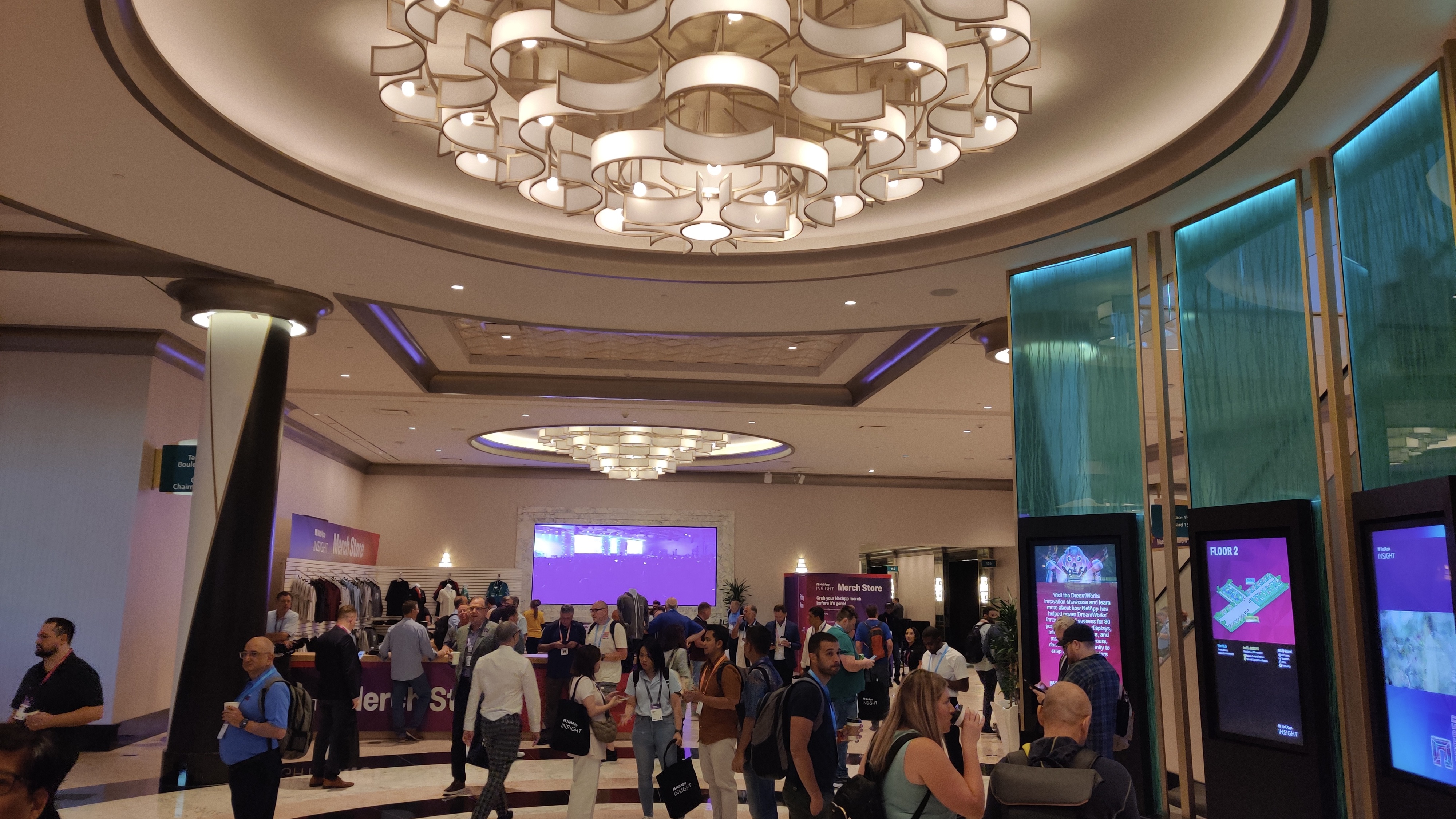
In the main foyer area of the conference center dance music pumps out from a Google Cloud-branded DJ booth.
Notably, Google Cloud is headed up by NetApp CEO George Kurian's twin brother Thomas, who appeared at Insight 2023 and could make another appearance this year. We'll have to wait and see...
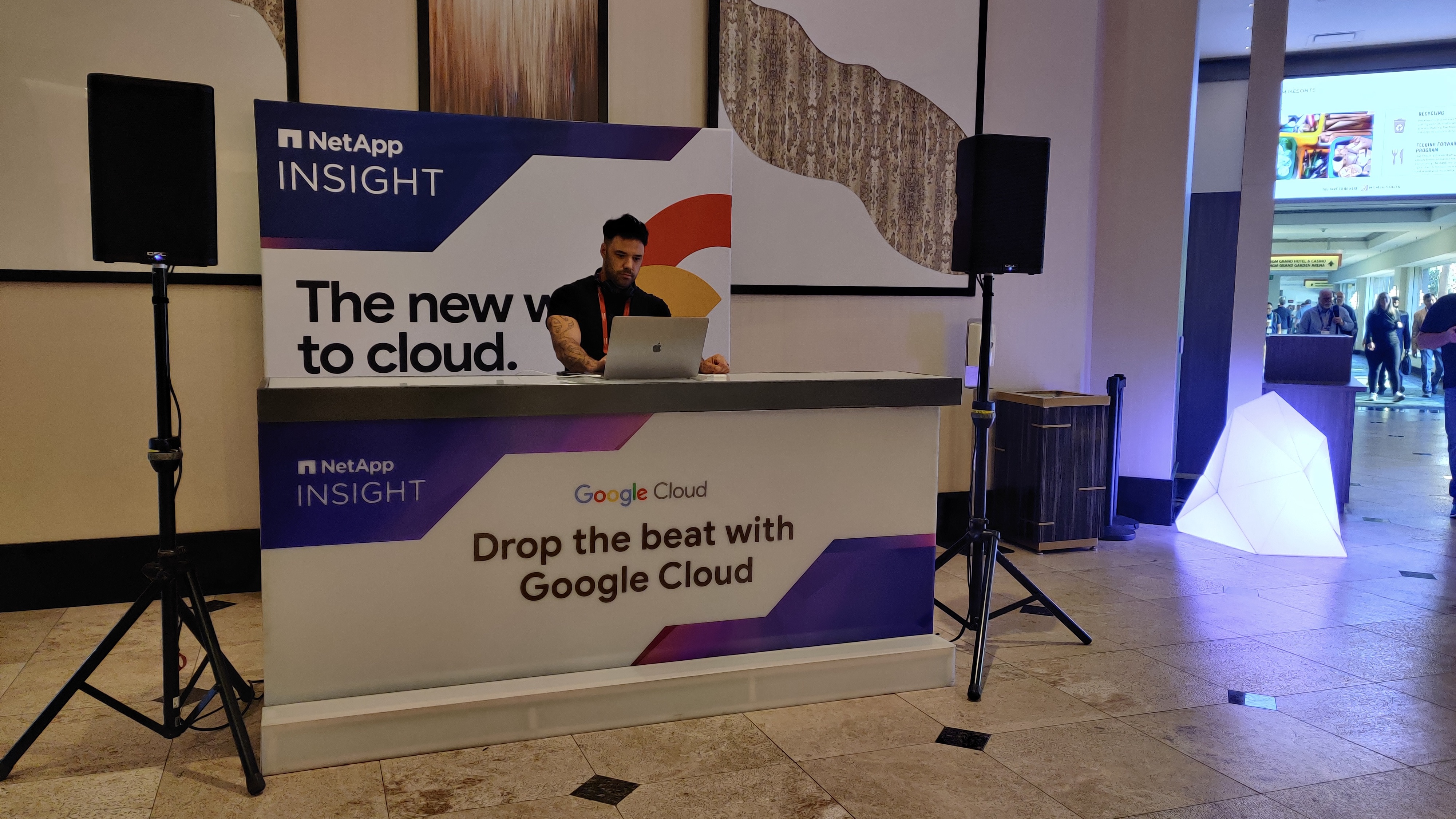
We’ve still got roughly two hours to go before today’s keynote is set to get started at roughly 4pm (PT). While we’re waiting for everything to kick off, why catch up on some of our coverage from the conference so far exploring what could be coming up over the next three days and the years ahead?
● NetApp could corner AI infrastructure at Insight 2024 – but customer hype will ride on its messaging
At Insight 2023, NetApp was laser-focused on positioning itself as the go-to data storage and management provider for businesses looking to accelerate their AI adoption. On the back of strong performance from itself and competitors over the last year, this year it will look to carry this moment into Insight 2024, and so its messaging around why it stands out in areas like AI-ready storage as well as both hybrid and multi-cloud, will be key.
While we wait for the main event to get started here’s some more pictures from around the convention center here in Las Vegas.
NetApp’s N-Powered branding is splashed all over the MGM Grand, representing the company’s promise to customers that it can modernize their data tooling and help them build intelligent data infrastructures.

As the sign says, things are heating up here in Las Vegas with less than one hour to go before the opening keynote of NetApp Inspire 2024.
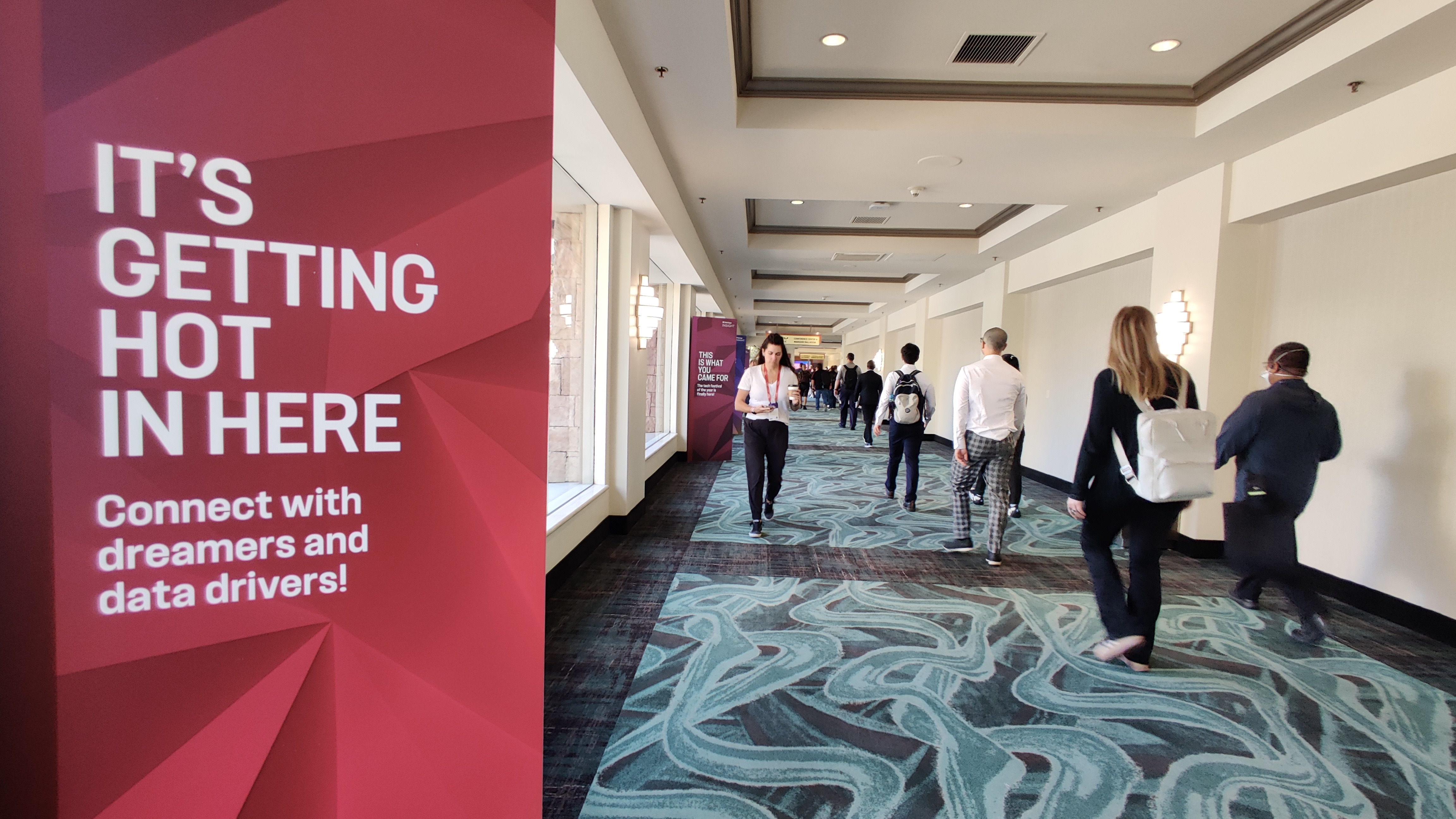
The crowd is growing in the conference, as the excitement builds before George Kurian's opening address.
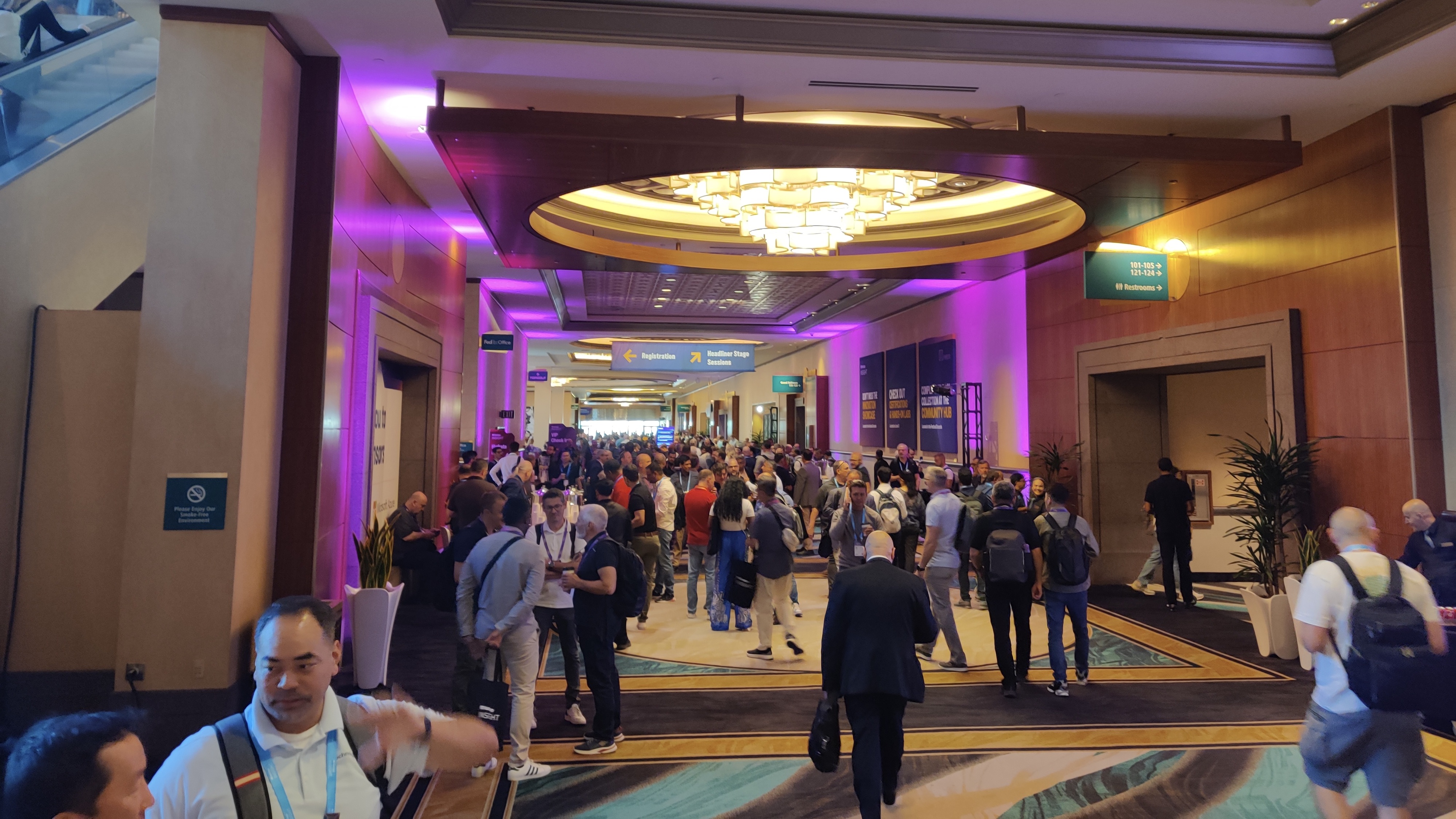
On entering the headliner stage the crowd is greeted with the dulcet tones of Pitbull. The DJ welcomes attendees from near and far, which is rather apt as 'Mr Worlwide' pumps out of the speakers.
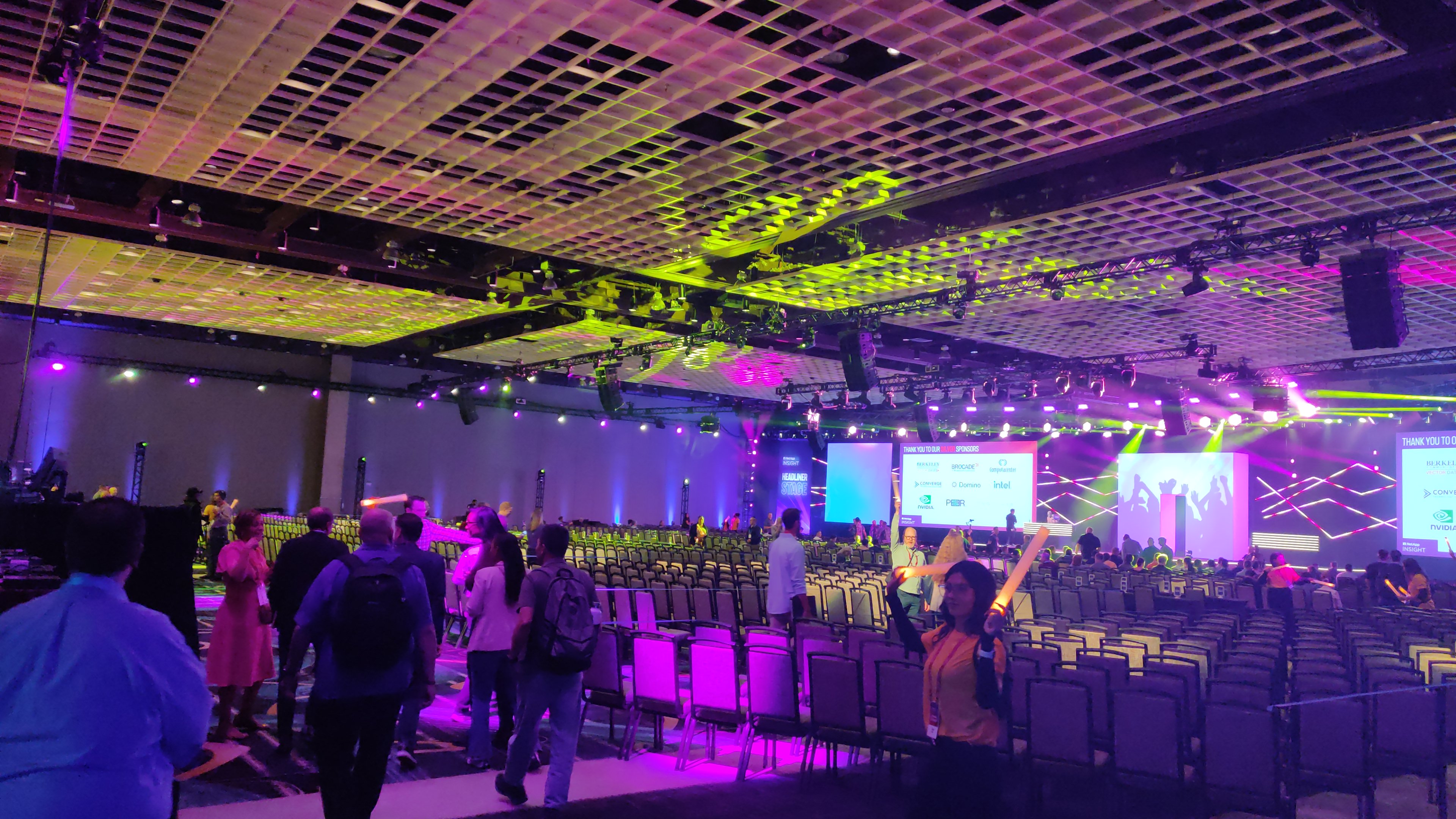
Here is a shot of DJ Graffiti who is making good use of the mic to get the crowd going.
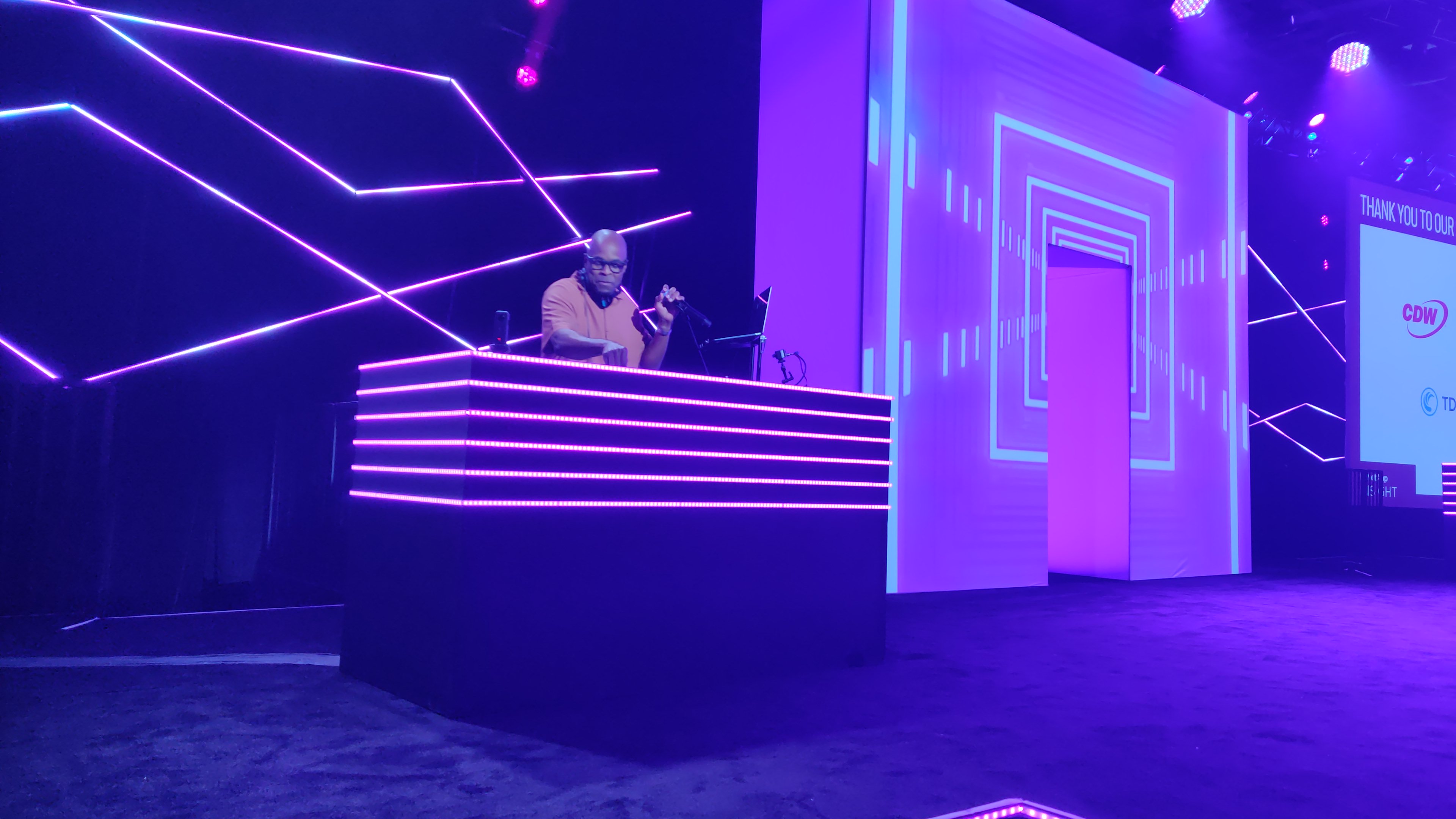
It's getting busy now as attendees flood into the auditorium. An emcee for proceedings is currently interviewing one delegate, who has just declared his love for 80s music.
We are now playing a guess the song game, and he guessed White Wedding by Billy Idol in a matter of seconds. Too easy!
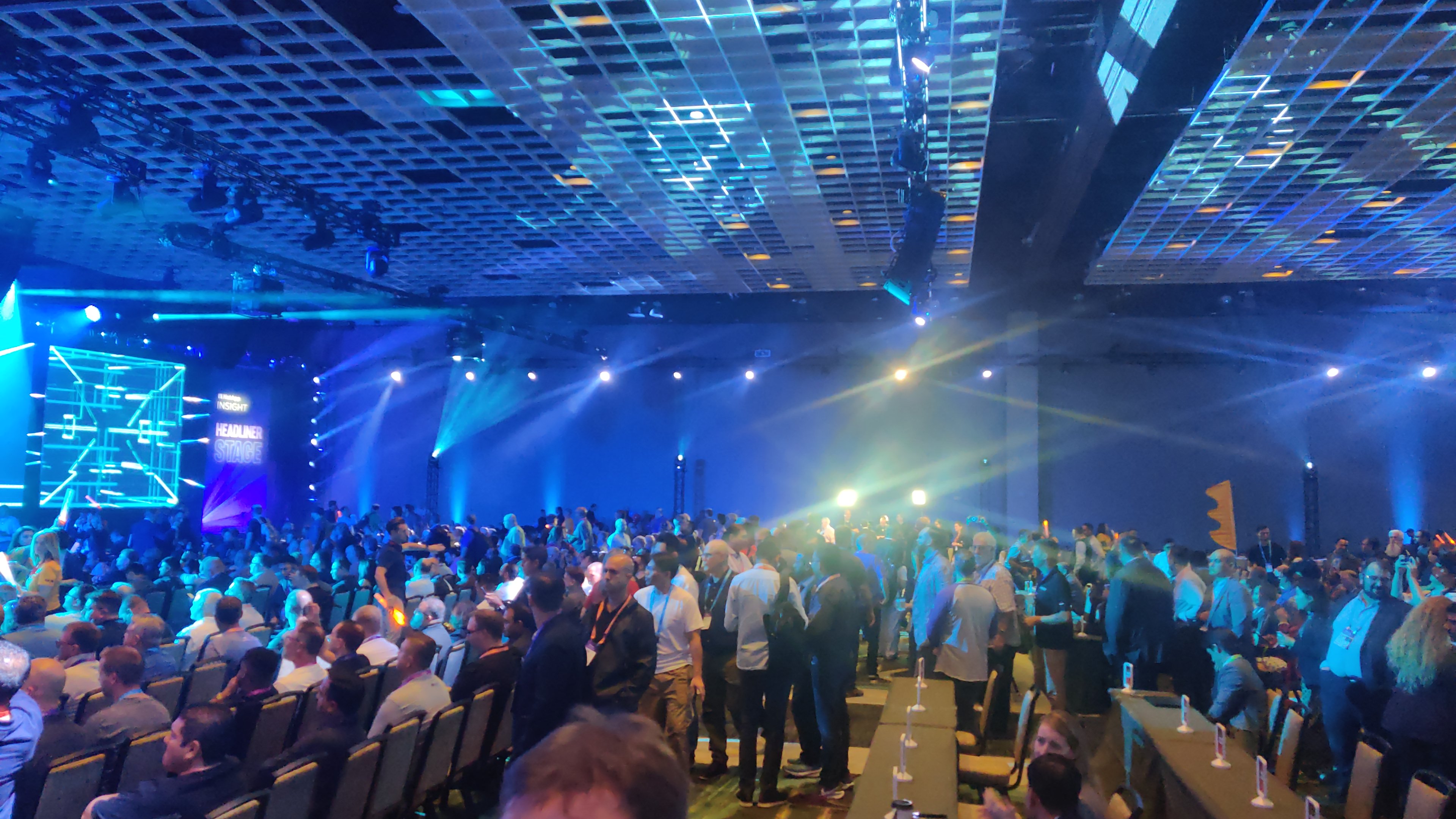
Our emcee is now interviewing Nick Howell, global cloud field CTO at NetApp, who is currently explaining why he doesn't like former Patriots quarterback Tom Brady.
Just minutes to go before we get started here in Las Vegas.
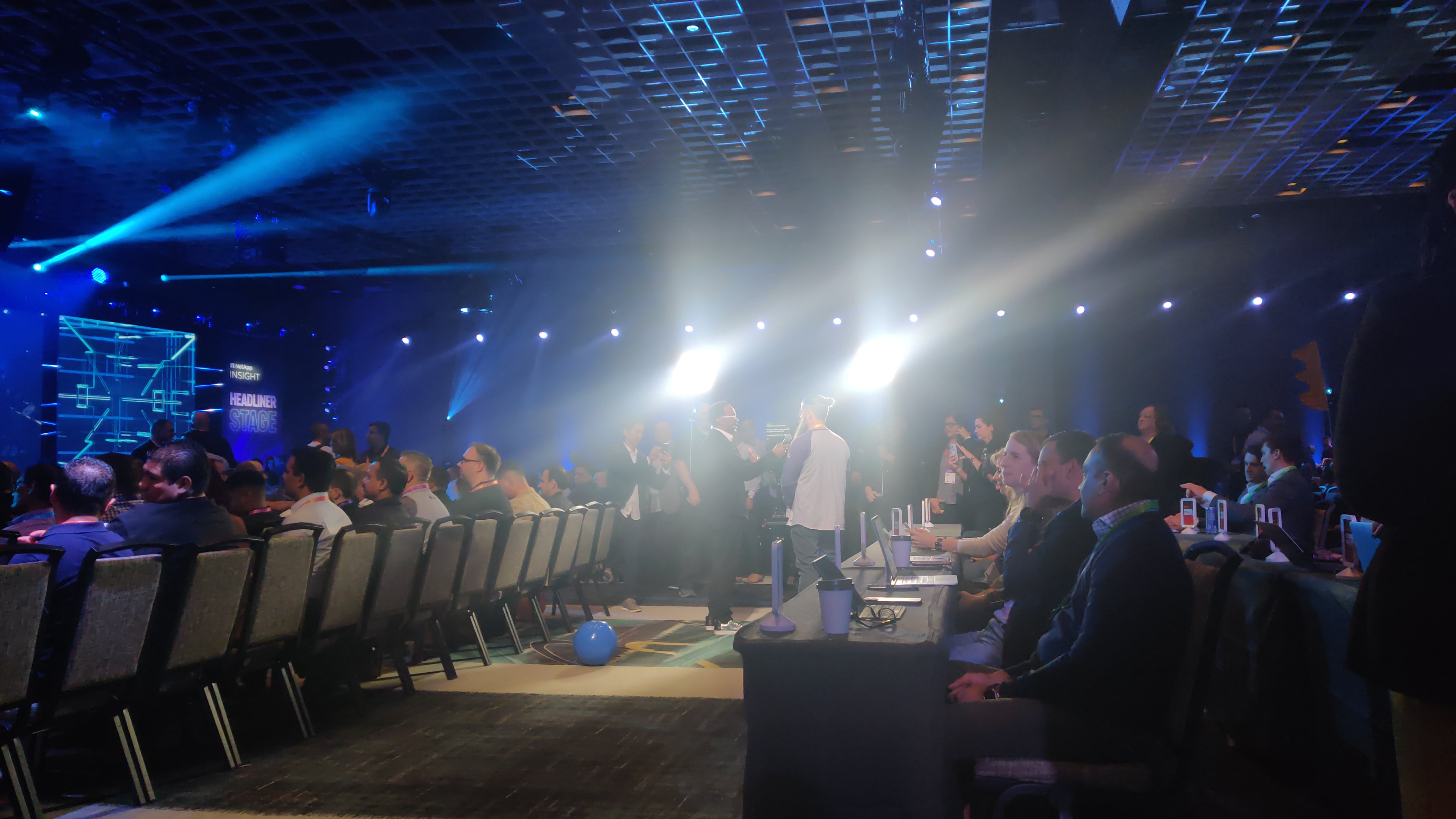
We're almost at capacity in the headliner stage, and our emcee Mario Armstrong announces we will be hearing from George Kurian imminently.
But not before he stages a giveaway for VIP passes to tomorrow's entertainment Royal Machines at sardonically-named Area 15.
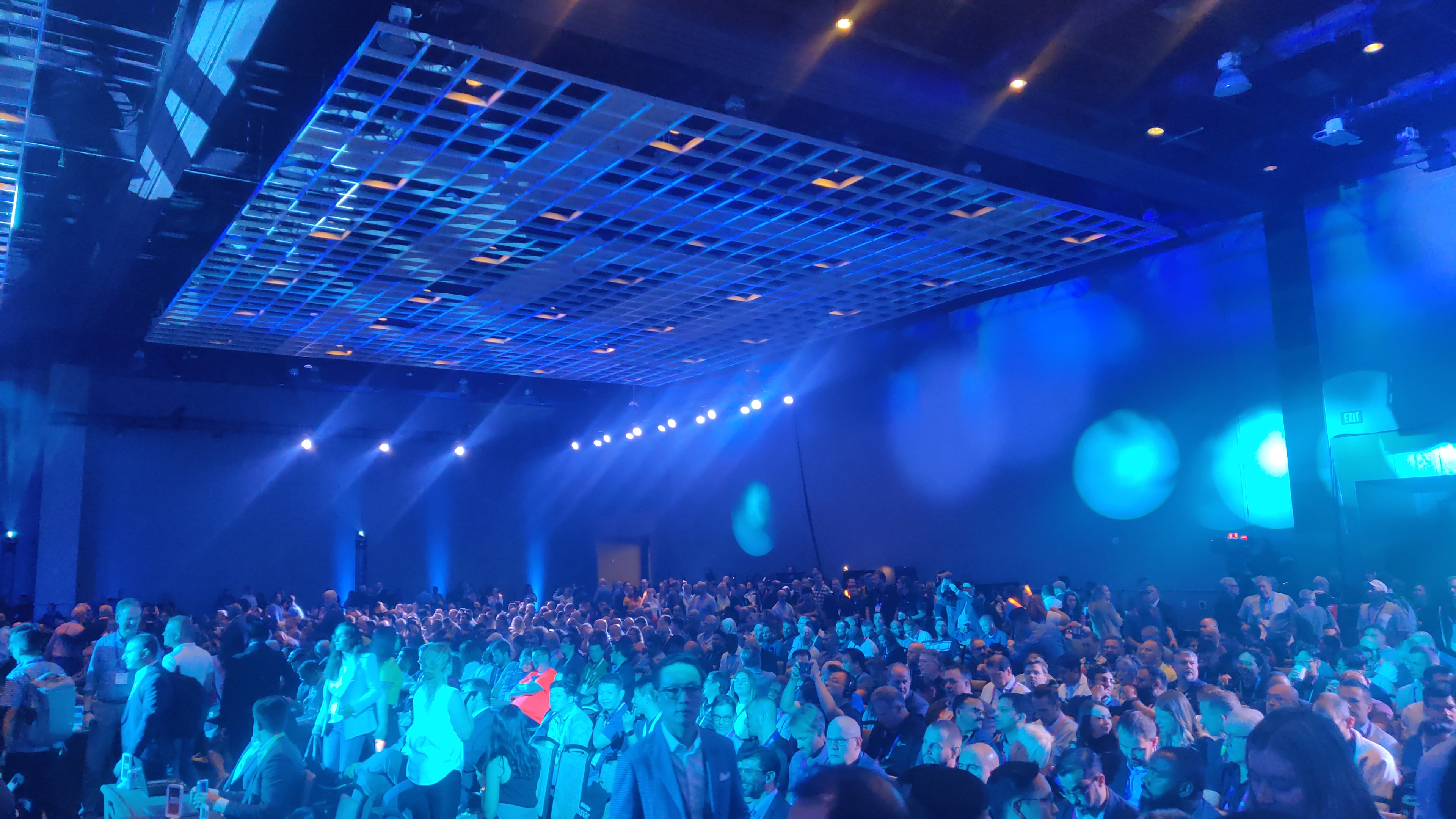
Ok! Here we go, the lights are dimmed and the obligatory showreel is running with some extravagant shots of cars speeding down roads and astronauts floating in space.
George Kurian has stepped onto the stage to rapturous applause. He thanks the delegates for attending.
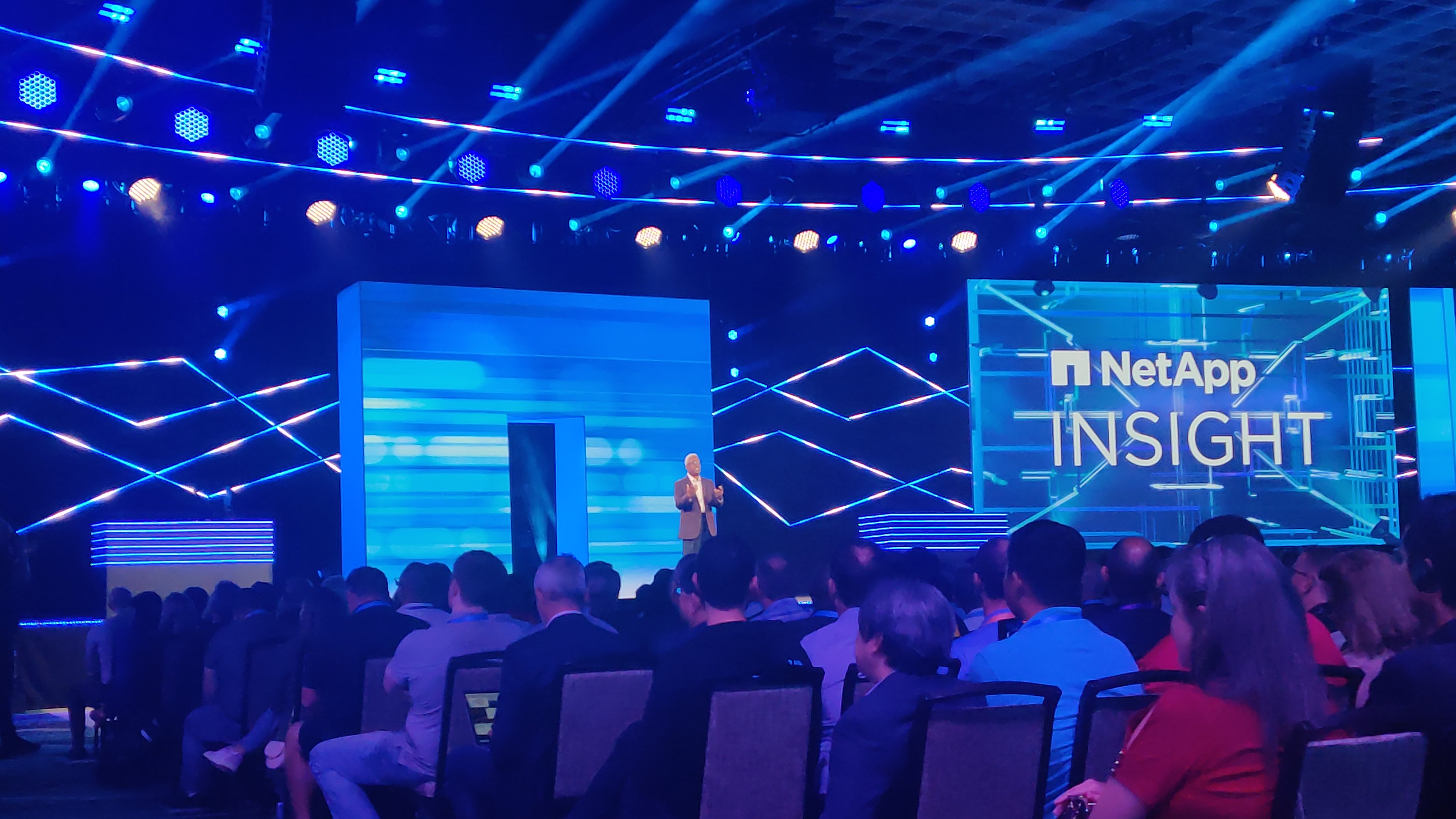
Kurian harks back to last year's Insight 2023 conference where he claimed there will be data leaders and data leaders in this AI era.
He outlined the three keys to success in leveraging AI to produce new value for enterprises around the world.
These three pillars are:
Data leaders need a cohesive data strategy, they need to treat data as a product in itself, and understand the foundations of a modern data architecture to leverage the inherent value in data.
Kurian says we are now in era of data and intelligence, which is handy considering NetApp are branding itself as the intelligent data infrastructure company.
He adds that many things have changed since last year, stating that we've seen a real breakthrough in AI, where AI systems can now understand the domains in which they operate, without the assistance of humans.
"These systems enable us to build rich immersive experiences, combining multimodal technologies to understand all the data that resides in your enterprise."
Kurian says we are in the third stage of the modern data revolution. The first of these stages was the basic digitization of analogue information. The second stage took place two decades ago, according to Kurian, when humans started developing a longitudinal history of a particular type of data to do basic trending and analysis.
Now, in the third stage of the modern era of data collection we need to go wider in the scope of data, as well as long in terms of detecting trends, Kurian states, and to do this businesses need to understand all of the data in their organization so they can get the best results.
Kurian adds that we need to recognize that the industry is at the juncture of two profound opportunities. First of these is the enormous growth in datasets, as well as the rapidly developing sophistication of the tools to analyze these datasets and produce insights.
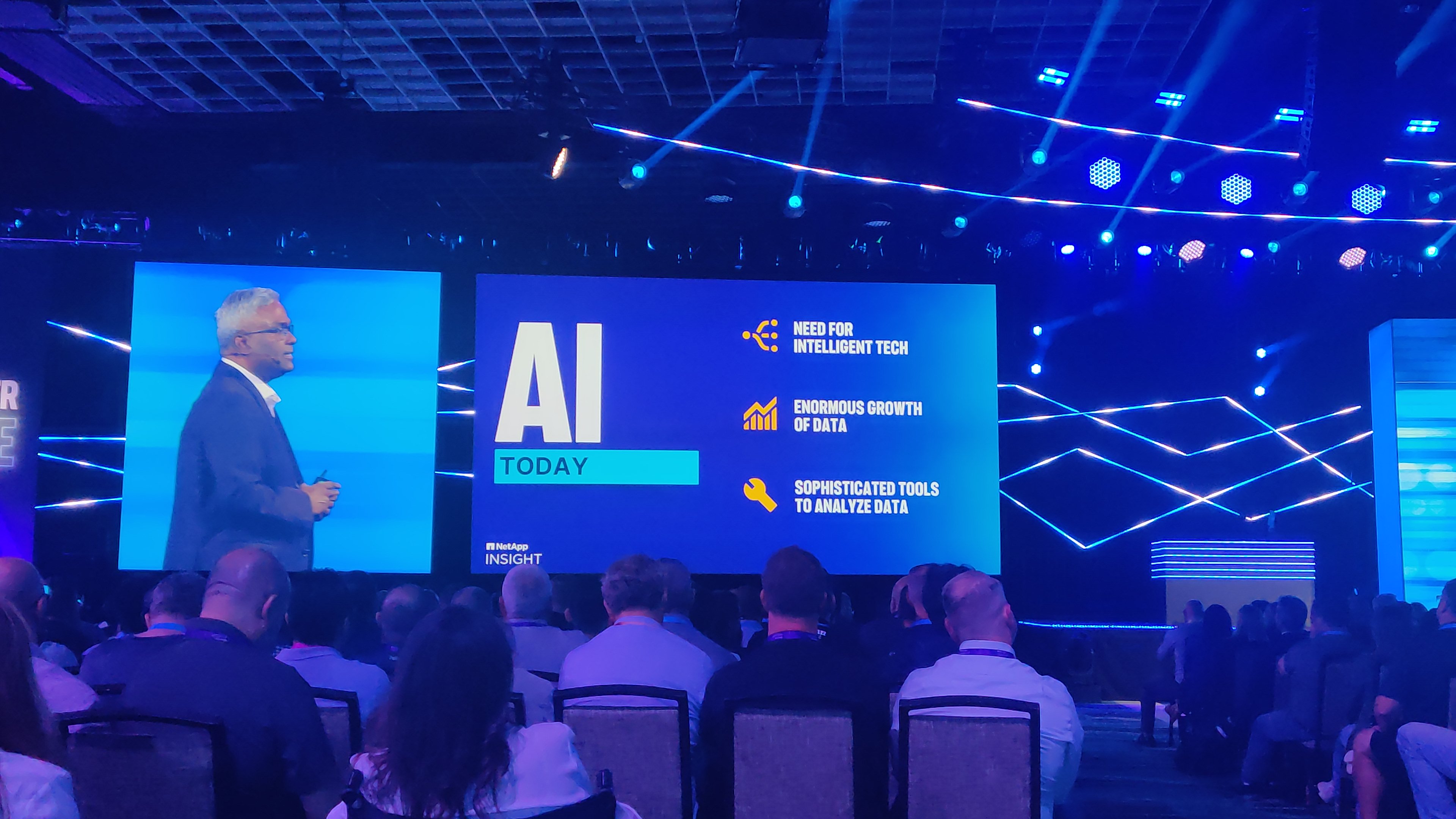
Next up we get a brief message from Satya Nadella, CEO of Microsoft, and then to celebrate the five-year anniversary of the general availability of Azure NetApp Files we are introduced to Girish Bablani, president of Microsoft Azure, who joins Kurian on stage.
Bablani offers an example of one of Microsoft and NetApp's customers, Coca Cola Bottlers of Japan.
Coca Cola Bottlers of Japan has one of the largest SAP DV2 workloads in thew world, Bablani explains, but with the help of Azure NetApp Files they were able to migrate this vast workload in five months without experiencing any operational downtime.
The firm was also able to achieve a 30% improvement in their TCO, a 49% improvement in their application performance, as well as a 90% improvement in their deployment time.
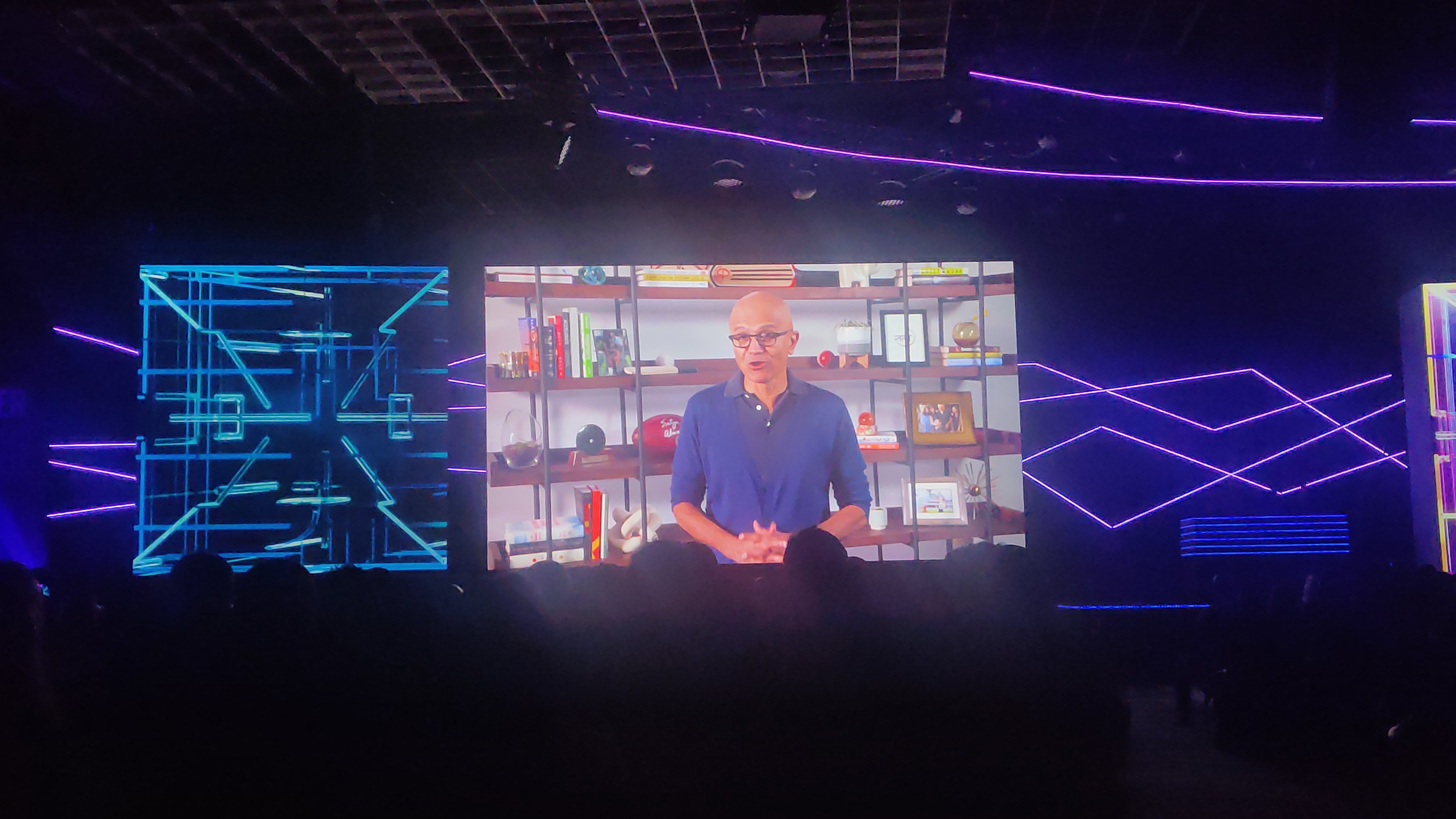
Bablani talks a little more about what he is excited about regarding AI in the coming years, he mentions Microsoft Copilot AI, no surprises there.
That's it from Bablani and now we are hearing from Kurian about the risks associated with AI. Kurian notes that of course any powerful tool like AI has inherent dangers to society.
He explains that aggregating data to provide insight will naturally lead to concerns around bias. Kurian touches on the some of the mathematical techniques that underpin the foundations of AI, regression and clustering were devloepd by French polymath Francis Galton, who also happened to be the founder of eugenics, which is certainly an interesting observation.
Now we have a video message from Mike Berry, chief financial officer at NetApp who is talking about how NetApp underwent their own digital transformation driven by leveraging their enterprise data.
Berry explains that NetApp was operating as three different silos in terms of data reporting, its storage business, the cloud arm, and its Keystone storage as a service business.
"This greatly impacted our operational efficiencies in a few ways. Number one our unmanaged data stores meant people were getting different answeres to the same questions."
Second, Berry explains that individual analysis of the data meant it couldn't scale insights to the entire enterprise. Finally NetApps legacy platforms couldn't process the increasing size of its data fast enough to support AI workloads.
"Today we have one data source that informs the entire business" he boasts.
One positive outcome from this transformation, Berry states, is that NetApp was able to reduce redundant data duplication by 65%.
"This really helps with having a single source of the truth across the entire enterprise and peraps most important, we are more agile and can innovate with new technologies like AI much more quickly."
That's it from Berry and Kurian is back on stage to talk about some of the challenges around getting the most out of AI.
Kurian explains that first amoung these hurdles is, the AI challenge, and these data challenges associated with AI comprise how enterprises select and unify data to build their business applications. It also covers how businesses govern this data in a responsible and ethical way.
Finally, businesses need to be able to ensure that their data is fresh and accurate, as the outputs AI models can generate are only as good as the data they are being fed.
Kurian adds that AI is a complicated and costly endeavor for any business, but today NetApp is reiterating its commitment to building an intelligent data infrastructure that builds a bridge between AI systems and data systems, and can manage that data the way it is supposed to be managed so that it can be leveraged for insights.
Ultimately what this means is bringing AI to your data, Kurian emphasises, and not the other way around, and doing so with solutions that are intelligent, agile, attainable, and secure.
This brings Kurian to three transformative data innovations NetApp has its sights on at Insight 2024:
- helping businesses understand and manage data for AI
- bringing AI to their enterprise data
- delivering the power of AI efficiently and securely.
We are now welcomed by Krish Vitaldevara, SVP and GM of platform at NetApp. Who wants to talk about making this vision real. To underscore this goal, Vitaldevara is helpfully wearing a T-shirt with 'bring AI to your data' printed on it.
Vitaldevara reiterates that the mission is to help customers get full value from their enterprise data, and this includes innovations across their technology stack.
Vitaldevara breaks a businesses tech stack, as it relates to implementing AI down into its infrastructure layer, with AI infrastructure that scales economically.
It also includes transforming the data layer in enterprises around the world, providing an integrated data engine that can make their data AI ready.
These solutions should also be inherently hybrid, multi-cloud, and ecosystem integrated, Vitaldevara states, a claim Kurian made at last years Insight 2023 conference.
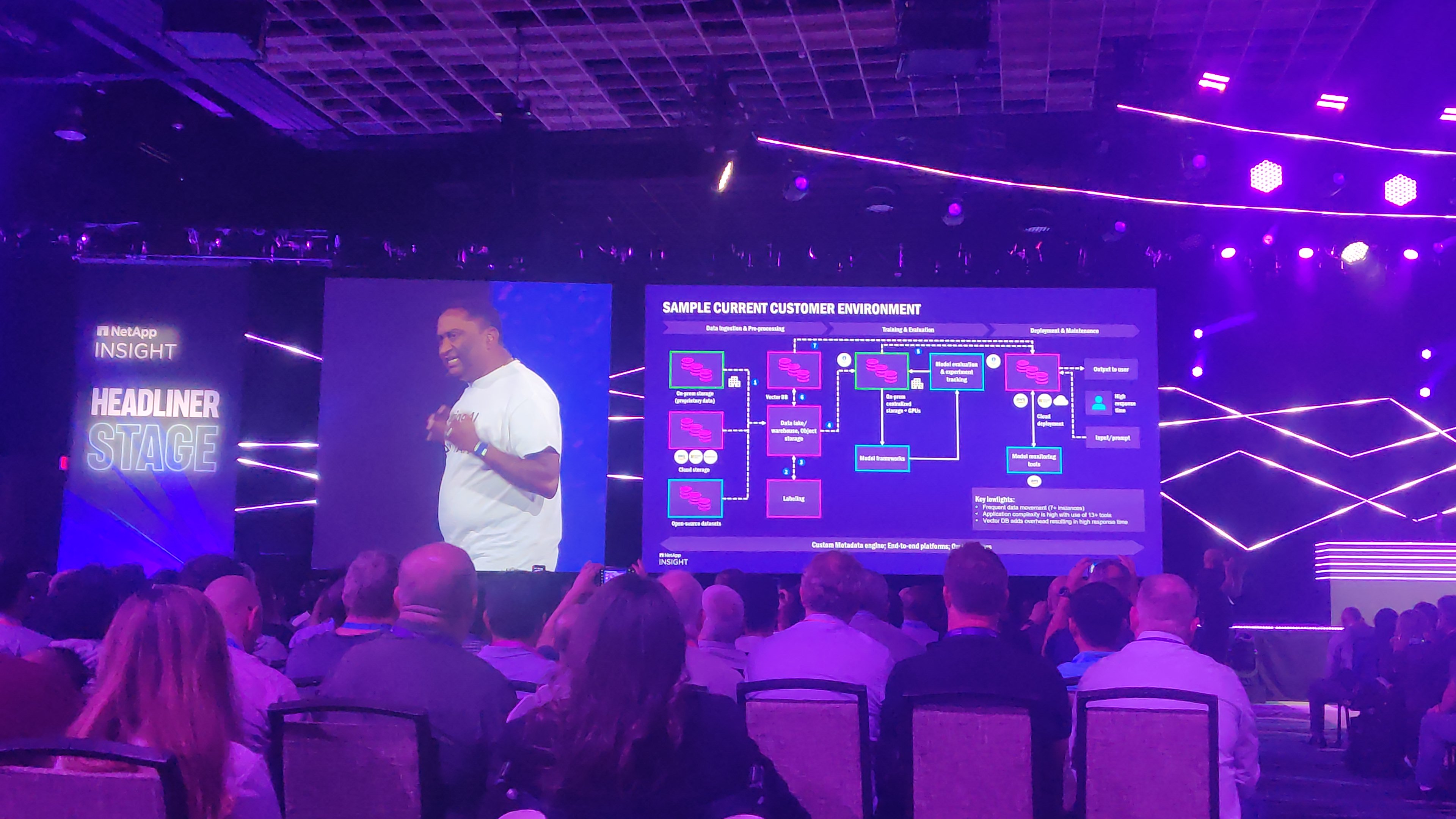
One way in which NetApp is helping transform the data layer for many businesses, Vitaldevara, is by bringing structure to the unstructured data where the real insights can be found.
NetApp are building a unified global metadata namespace, Vitaldevara states, which will provide businesses with an easily synthesized, single unified global view of the data. This basically means overlaying structure over the top of unstructured data sets.
Vitaldevara dives into an example in BlueXP NetApp's hybrid multi-cloud control plane, which has been prepopulated with various untapped data sources, showing how this solution brings new functionality for users.
After Vitaldevara finished up with his demo, he gives way to Kurian, who introduces our next guest Monica Jain, director of R&D data science at pharmaceutical giant Johnson and Johnson.
Jain is here to talk about her experiences at J&J driving data transformation in order to leverage AI.
She explains that there were a number of challenges to optimizing the firm's data for AI workloads. First among these is data quality, which as Kurian noted earlier significantly impacts the quality of outputs which in her industry can have incredibly serious negative impacts on the lives of patients around the world.
As a result making sure the the data is clean is a primary challenge, Jain explains.
Next is breaking down silos and integrating many different data sources. In J&J's case can include diverse datasets from various siloed inputs including field trials, medical studies, and real world data.
As a result, Jain says data mobility is a key piece that NetApp's solutions were able to provide.
Jain is now discussing how vital a hybrid cloud architecture has been in providing the company with the flexibility, cost-efficiency, and performance her organization requires to implementing AI effectively.
Operating in the medical industry, Johnson & Johnson is responsible for highly sensitive data that is subject to stringent regulatory requirements, she notes, which they prefer to keep on premise.
"This approach allows us to maintain very tight control over security compliance and data governance, which is the key to ensuring that we meet all of our industry standards and protect patients' privacy"
On the other hand, she states they are moving less sensitive, high volume, and compute intensive workloads to the cloud, including data used in large scale AI model training and analytics and machine learning experiments where scalability, flexibility, and advanced computational power and the cloud provides significant advantages.
Johnson & Johnson are utilizing NetApp to help sort and manage costs, allowing the firm to have divided workloads in different environments.
That's it from Jain, and almost immediately Kurian is welcoming Matt Wood, VP of AI products at AWS on stage.
Wood begins with what seems like the obligatory AI statement, "Generative AI is probably the single largest shift in how we're going to interact with data and with each other since the advent of the very earliest internet."
But we quickly move on to what Wood thinks are the most important AI use cases.
First, he says there are those organizations that want to 'get into the weeds' of building and optimizing their own models. For these firms Wood says AWS makes a broad set of accelerated chips available.
These include some from partners, like Nvidia, and some that AWS produce like their Trainium or Inferentia systems, which he says are designed to deliver the lowest cost per dollar and lowest cost per watt for ML training on AWS.
This is where Amazon FSx for NetApp ONTAP comes in, he says. "You really want to get the data onto those chips as quickly as possible to build these remarkable models and to be able to use them with your own data when you're running predictions against them."
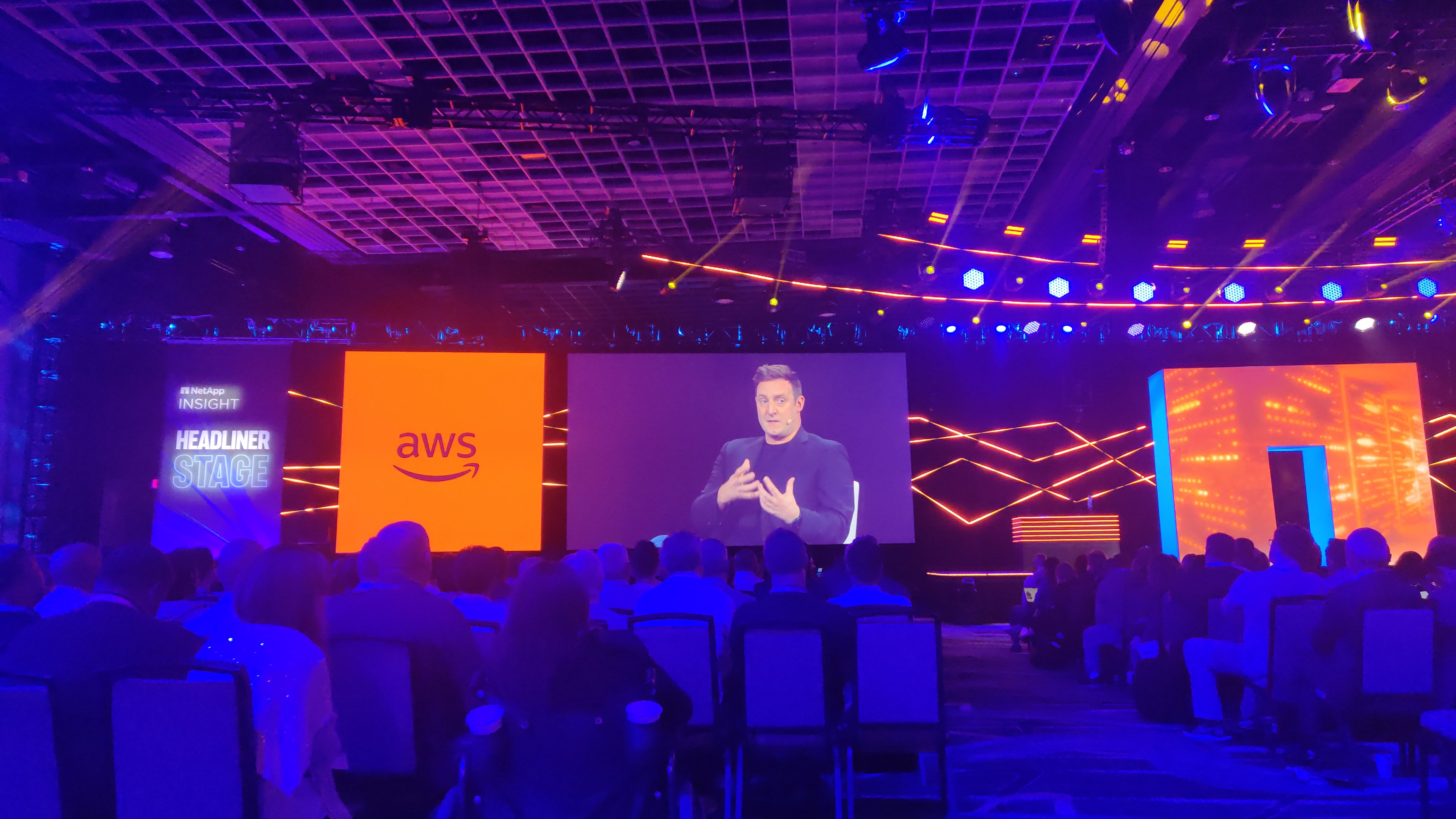
Wood says AWS also offers the Amazon Bedrock service, which allows firms to pick from a range of pretrained models that they can start building inside their applications moving forward.
"We believe there is no one model to rule them all so we have a range of 32 foundation models. We make it super easy to evaluate them and the one that works well for your organization and for your use case."
Finally, Wood says that AWS also makes a set of applications available for those firms that don't want to 'futz' around with models and just want to be able to use the application with their knowledge workers or support teams, for instance.
Wood says these are the three main use cases that he sees from customers.
Kurian moves onto AWS and NetApp's joint solution, Amazon FSx for NetApp ONTAP, saying that they are seeing accelerating joint innovation, service growth, and records for the service each quarter.
He asks Wood what it is that customers like about the solution. Wood says he thinks it comes down to security.
"When customers start their generative AI journey they have this schism in their mind, and I can understand where it comes from, that in order to be successful they have to make some negative tradeoffs as it pertains to the confidentiality and security of their data."
Wood says that this isn't the case with FSx ONTAP and customers get full visibility over what data gets used where, which he says is just a very different model to many other generative AI infrastructure solutions on the market.
Kurian's final question for Wood is whether his call to action for customers would be 'get your data ready', he agrees, getting your data in order means businesses can extract the latent value in much of the data they already have.
He describes it as low-hanging fruit across all enterprise data, and to be able to quickly, safely inspect that information in new ways will open up myriad new opportunities for customers.
That's it from Wood and he thanks the crowd before exiting the stage. This brings the opening day's keynote to an end as Kurian summarises the key messages from today's session, stating the pillars to success in the data and intelligence era are your uniqe enterpris data and your data strategy.
He concludes that NetApp will bridge the chasm that exists between firms' AI systems and their enterprise data, bringing the AI to their data, wherever and however they store it.
That's it for today, but be sure to tune in at 9am PT tomorrow as we get ready for a flurry of new product announcements to NetApp's storage line, cloud services, and more!
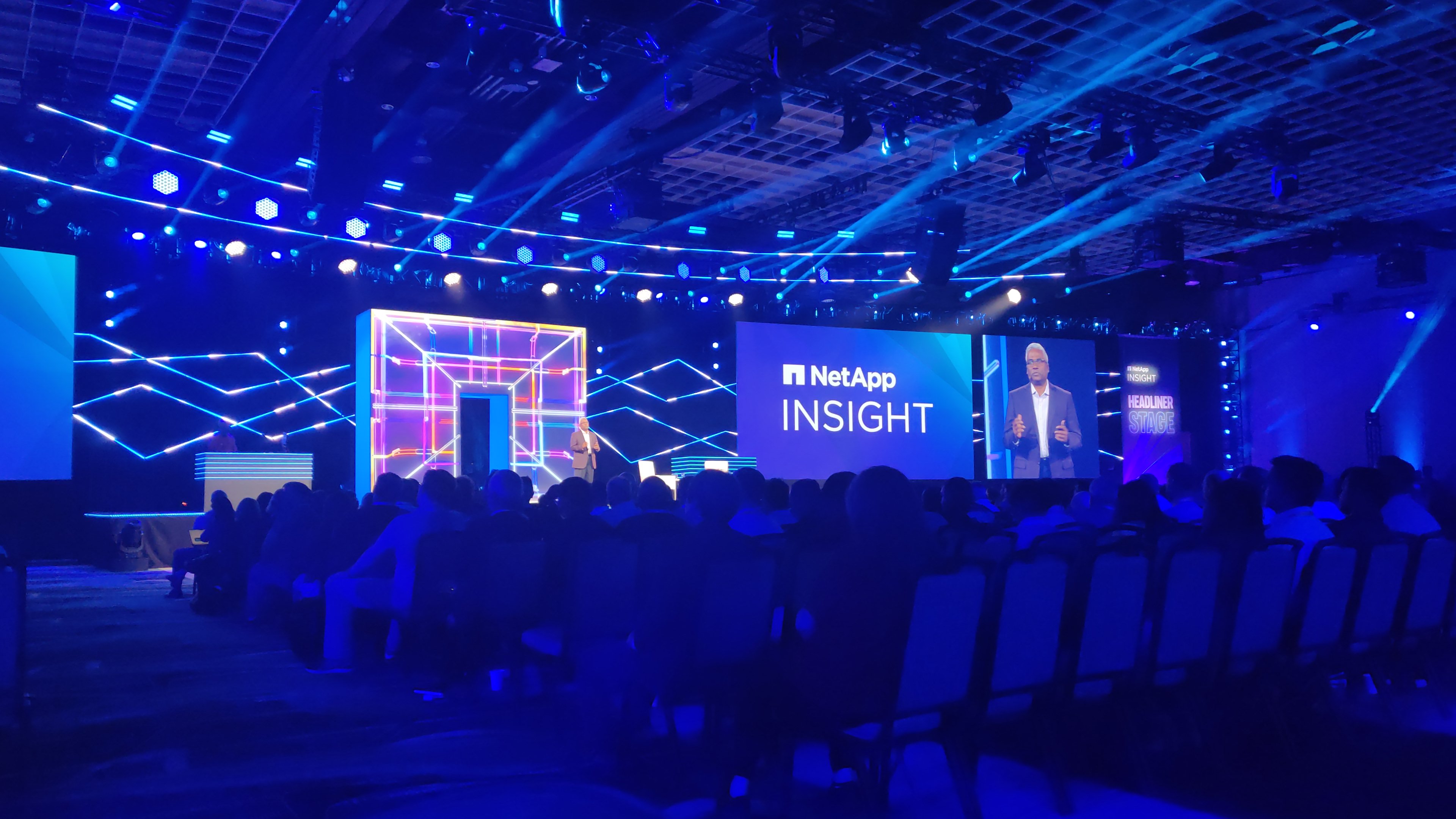
Yesterday we heard from George Kurian about how the industry is currently sitting at an inflection point in what he described as the third phase of the modern data revolution. This new phase, Kurian explained, is one where businesses should be able to fully understand all of the data in their organization, and use it to generate new insights and drive productivity, all with the help of NetApp’s intelligent data infrastructure solutions.
Today we will get to see Harv Bhela, EVP and chief product officer at NetApp, and Sandeep Singh, SVP and GMof enterprise storage run through all the latest updates to NetApp’s storage ecosystem. Then Pravjit Tiwana, SVP and GM of cloud storage will join us to talk all things cloud, and update us on how NetApp’s strong commitment to hybrid and multi-cloud has fared over the course of the last year.
Haiyan Song, EVP of cloud operations, will also be presenting today, walking us through new announcements from the segment, which has undergone something of a rebrand to tie in more closely with NetApp's intelligent data infrastructure messaging.
Song will also be talking to some NetApp customers including a major animation studio in the US, I’m reliably informed, about their work together to overhaul their data infrastructure in order to leverage AI and facilitate more efficient operations across a distributed workforce.
It's another invariably sunny day here in Las Vegas, and attendees have begun trickling down through the labyrinthine complex towards the complex center.
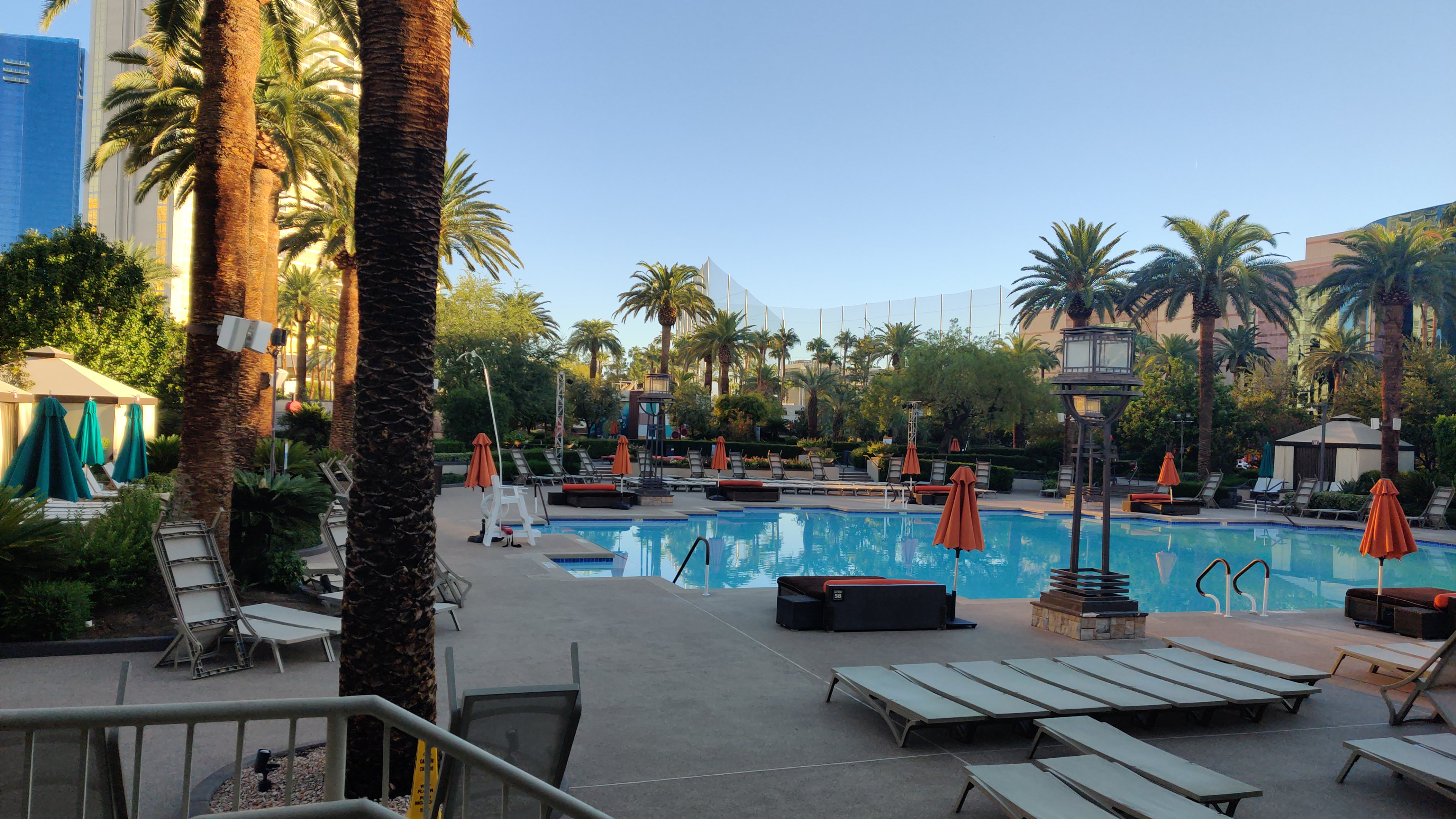
Things are still pretty quiet this morning, as just a handful of attendees move around the corridors outside the headliner stage getting their coffee before minutes before the main event gets underway in about 40 minutes.
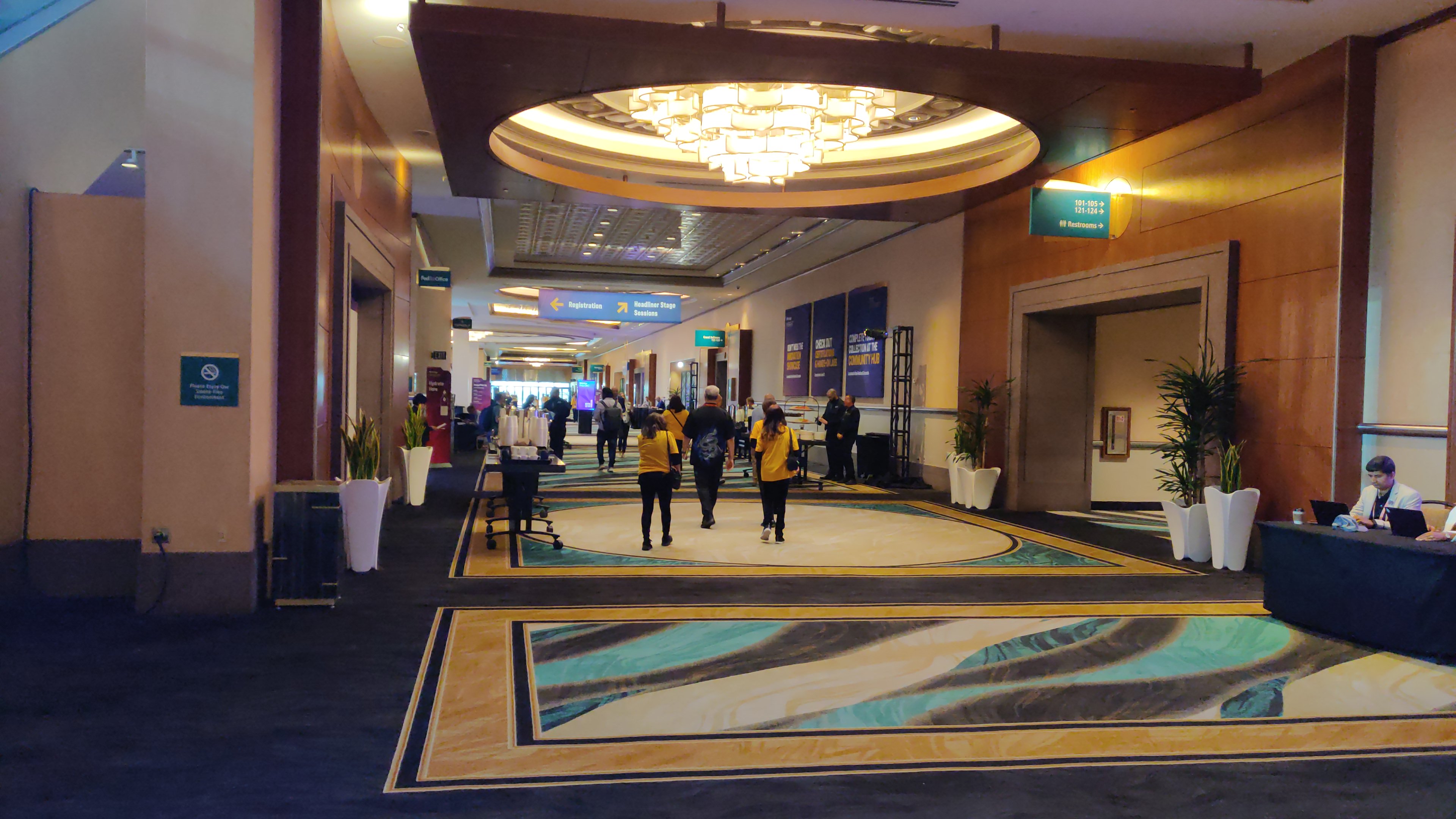
The crowd is certainly growing now with just 30 minutes before the start of the day-two keynote.
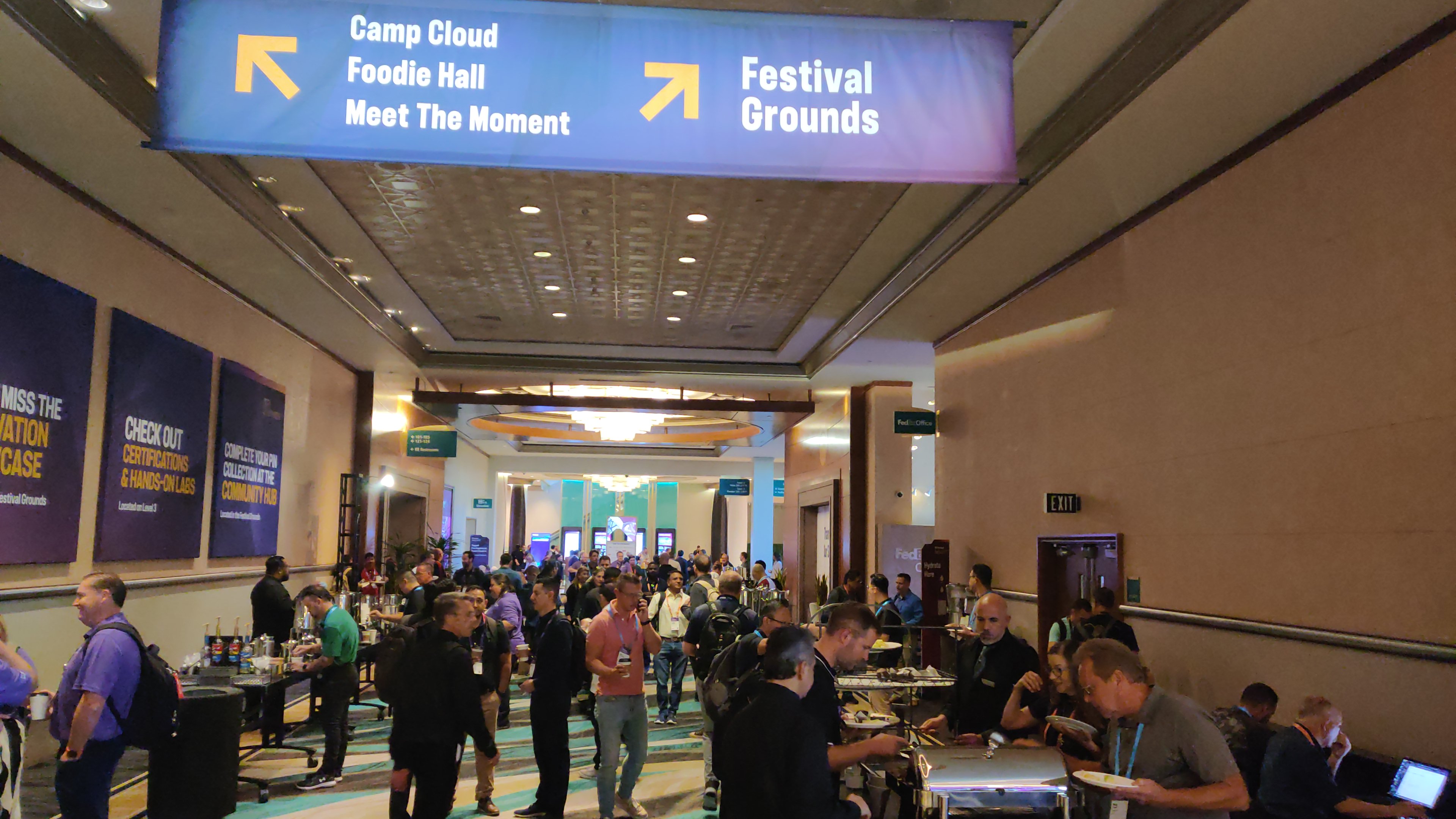
The doors are flung open and we have been let into the arena, a steady stream of delegates makes their way into the auditorium as DJ Graffiti plays some high energy club mixes.
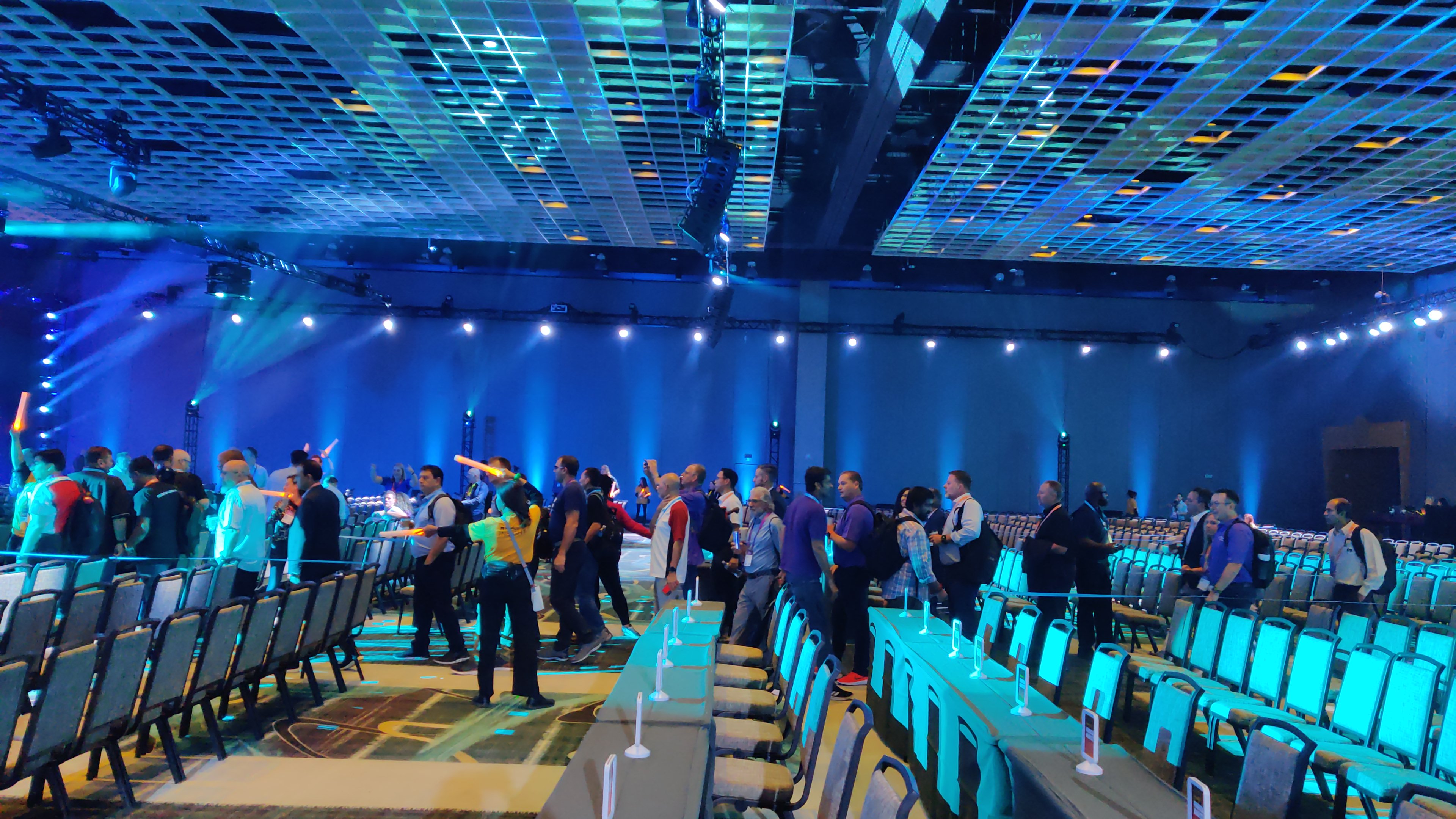
Our lively host Mario Armstrong is now onstage welcoming everyon einto the arena, before giving way to a video reel announcing the winner of NetApp's social impact award: NMDP a nonprofit organization that used AI and advanced data analytics to help provide transplants of bone marrow for patients with blood diseases.
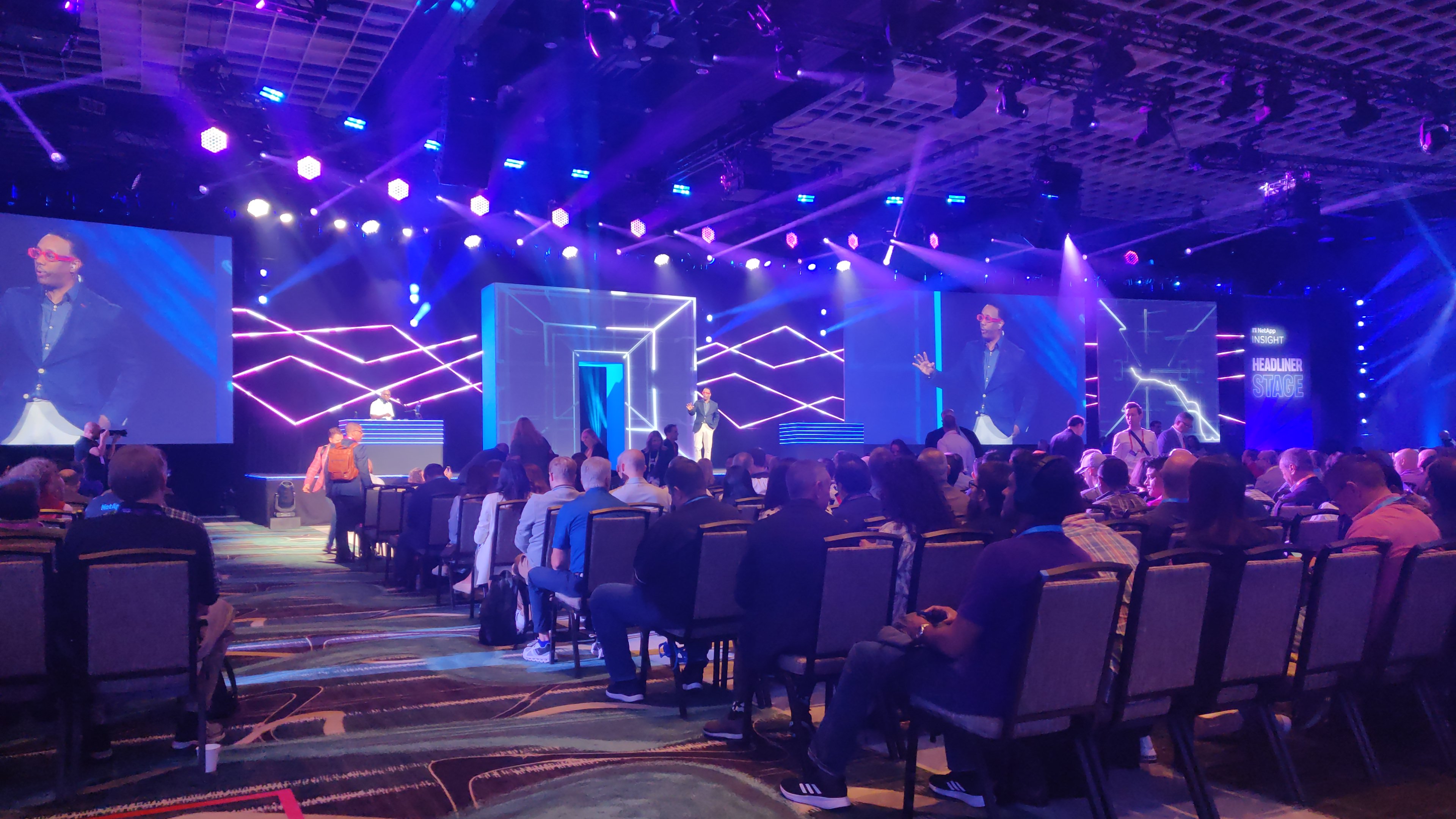
Now it's time to really get started, Mario is briefly reading a disclaimer before we get stuck in, the lights are dimmed and music blares from the PA.
First up its Harv Bhela, EVP and chief product officer who says he's here to discuss what NetApp have been hearing from customers, and how the firm can help them solve their biggest data challenges.
He goes back over George Kurian's claim that we are in the era of data and intelligence. But to unlock the value in your data businesses need to overcome some problems, Bhera adds, including the exponential growth of data, numerous silos, and the fact that data is constantly under threat.
"Without overcoming these challenges you cannot unlock the value of your data. At NetApp our entire mission is to help you with that transformation."
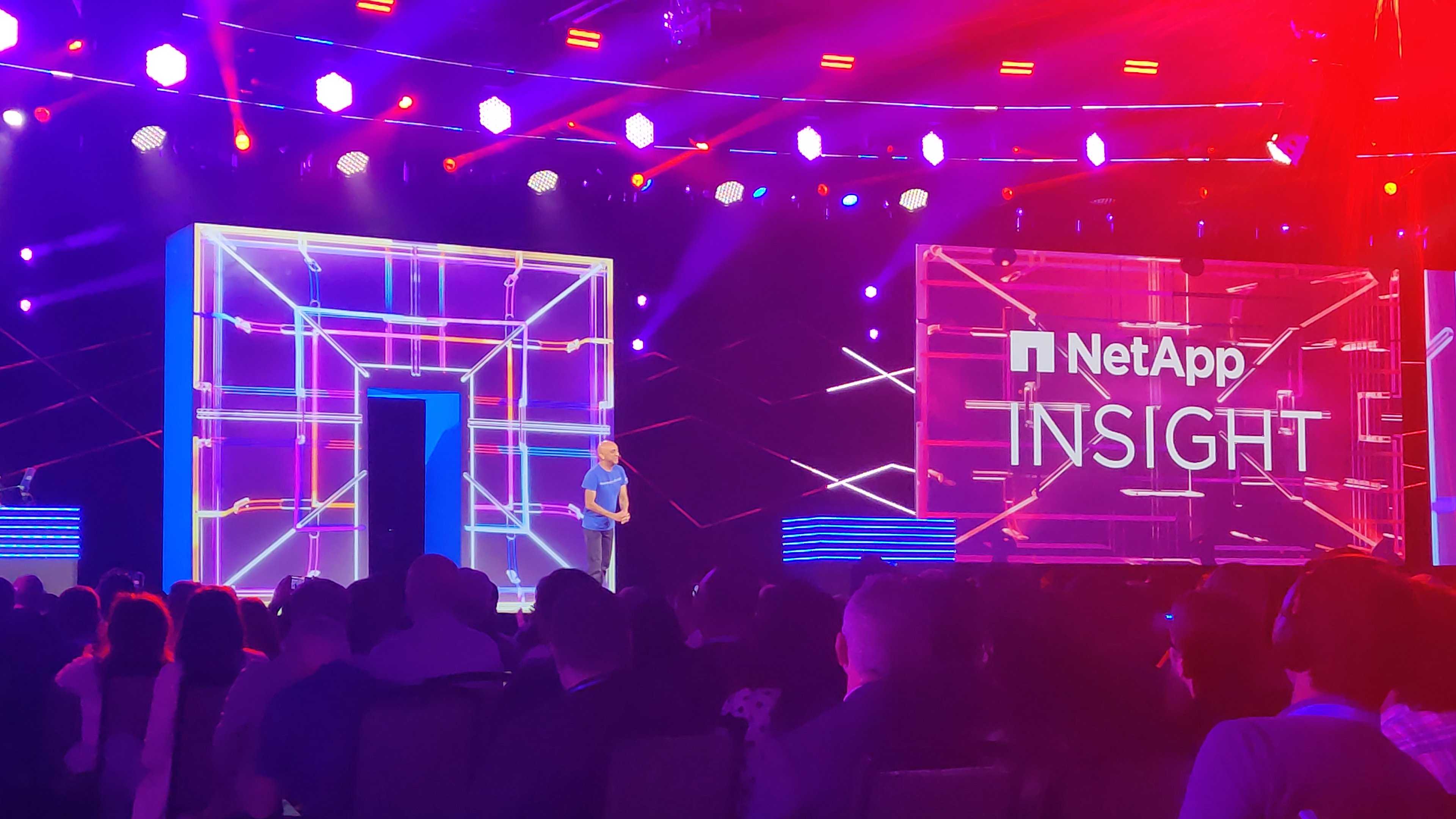
Bhela lists four key innovation areas where NetApp is working. First is enterprise storage. Bhela says this is the meal and soul at the core of what we do NetApp, who offer most comprehensive storage portfolio in the industry he claims.
Bhela says the new C-series all flash storage option became the fastest growing storage product in the company's history. For cost effective solutions NetApp brought in the AFA series he notes.
The second area is cloud storage, where Bhela says NetApp are best in the market for workloads across myriad providers including SAP, VMWare, and more. He says customers wanted solutions for their data across various public cloud options, and NetApp answered in the last year bringing out first party storage service in Google Cloud.
Moving onto security, Bhela adds customers said ransomware has become a board-level priority for them. To meet these concerns NetApp have brought out a built in ransomware service into their ONTAP architecture. As well as a ransomware recovery service, adding no other storage company in the world has all of these protections built in.
He teases that later in the keynote NetAPP will outline new innovations that will take their detection capabilities to the next level.
Rocketing through, Bhela is now onto the fourth pillar: AI. NetApp have delivered direct integration with several AI workflow tools to remove productivity blockers reported from customers.
Another innovation Bhela wants to touch on is the helping businesses deploy AI responsibly, including features allowing them trace model versions back to the specific data set they used.
That was very quick, and Bhela has invited Sandeep Singh, SVP and GM of enterprise storage on stage to go deeper on what NetApp has been doing with their unified data storage portfolio.
Singh says NetApp have expanded their portfolio to include capacity flash with the introduction of C-series, which as Bhela noted has become the fastest growing product in their history.
NetApp doubled down with AFF A-series, Singh adds, as well as the ASA system to accelerate VMware and database workloads, noting the momentum around this product has been "truly amazing".
Today he says NetApp is upping the innovation ante once again. We are on SAN workloads where customers have had to choose between simplicity and performance, forced to comprise which he says has held back modernization efforts.
No more he says, it's time to introduce the ASA A Series, the lights are dimmed and atmospheric music plays as a number of ASA A Series racks are rolled onto the stage.
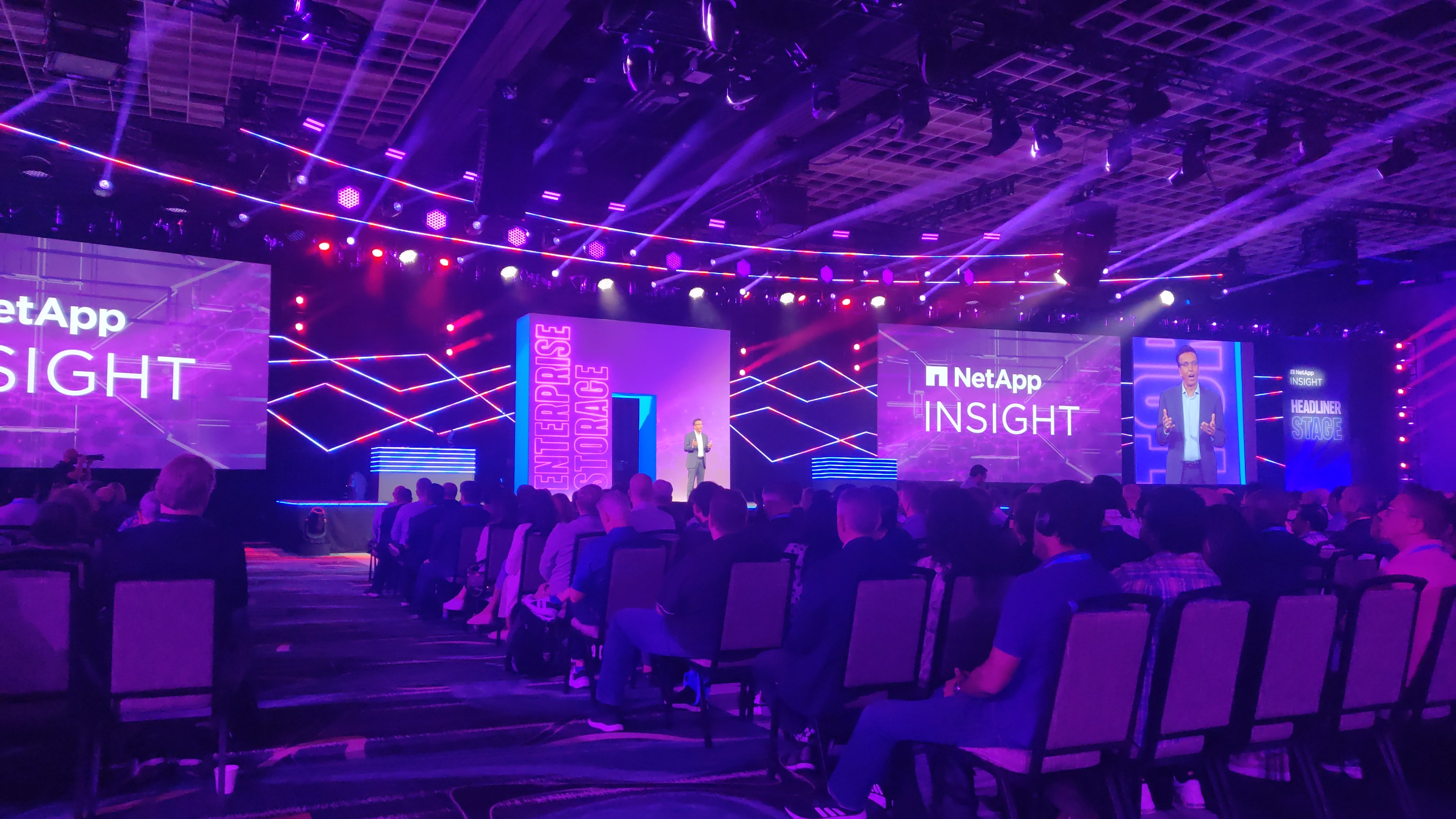
The ASA A series gives customers three key advantages Singh says, simplicity, power, and affordability. They are in simple to deploy and scale, as well as manage, with built in AIOps, and deep integrations with VMware. The new systems comprise the ASA A70, A90, and A1K block storage arrays which it promises will giver performance boosts of 109%, 88%, and 50% respectively.
The ASA A series offers unmatched affordability too he says. NetApp claims the new solution will offer 25 - 50% lower upfront price and better ROI over time. The arrays’ low power consumption and low operational overhead cuts their TCO over time too.
NetApp says ASA can help customers who love their ONTAP experience bring that experience to their block storage workloads, bringing simplicty at scale.
To put their simplicity to the test, Singh says he gave the solutions to one of their marketing interns and rolls some video reel where Kathy shows how easy it is to set up ASA in 60 seconds (she actually does it in 20) using in the system manager dashboard.
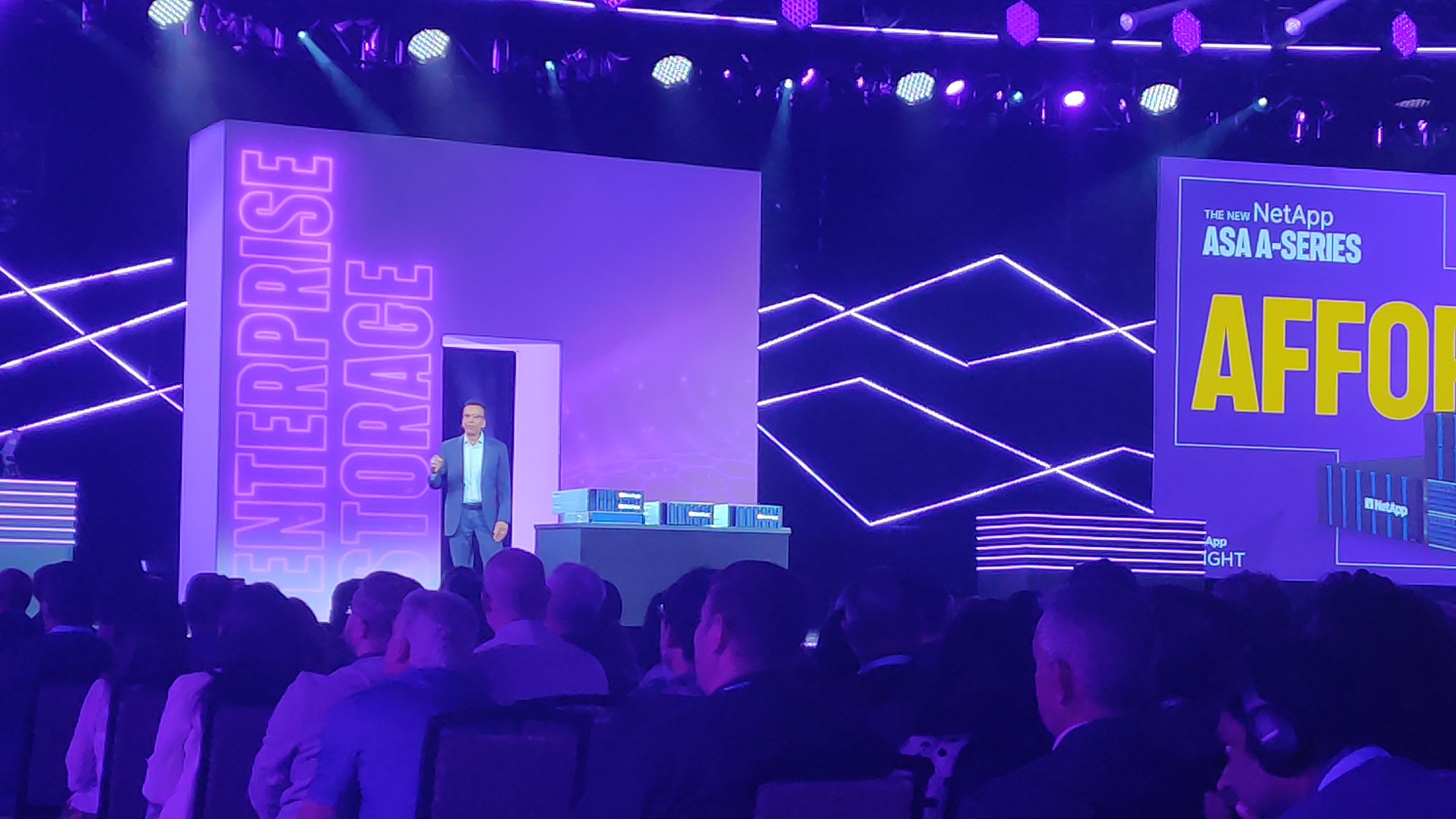
With primary storage out of the way, Singh is now covering NetApp's moves in secondary storage. Today he announces the introduction of the FAS 70 and 90 storage systems, which he says are economical, simple, and secure.
NetApp says these systems are ideal for achieving a low cost of data over its lifecycling by auto-tiering cold data.
Typically 60% or more of the data in secondary storage is cold data and NetApp can automatically and granularly tier that data to lower cost storage thus optimizing the cost of the data itself.
"Powered by ONTAP the new FAS systems are ideal for data tiering, cyber vault, and ransomware recovery."
Singh say no hybrid storage offering would be complete without a storage as a service offering, which brings him to Keystone, formally known as insights to data infrastructure insights.
Singh says keystone continues to gather momentum, offering 0% attrition but says he will be talking more about that later in the keynote.
Here's a picture of a handy summary of NetApp's storage portfolio.
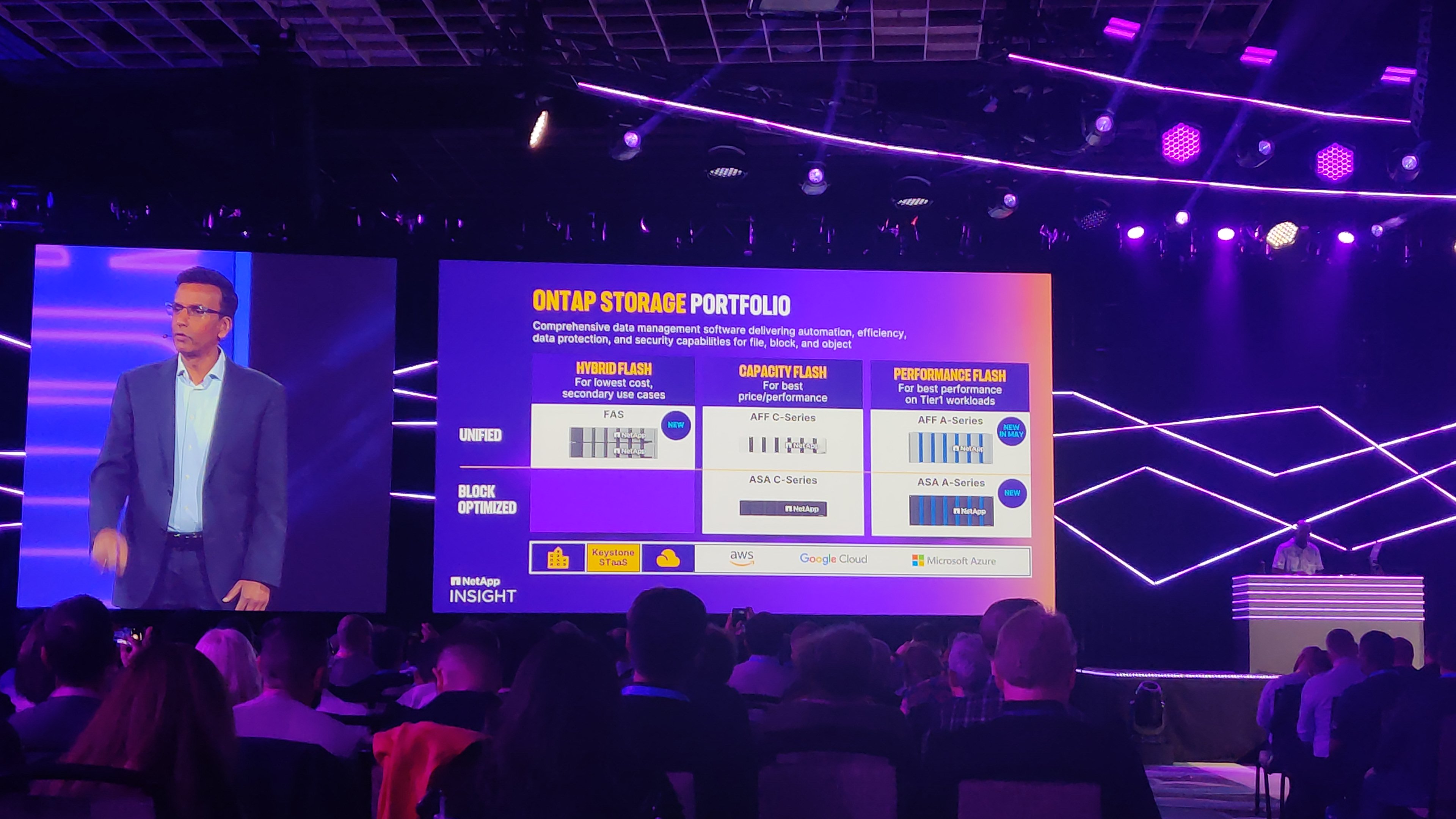
Now we have Pravjit Tiwan, SVP and GM cloud storage on stage to talk about all things cloud storage.
He says they have seen 20% growth in cloud storage customers, with a 114% increase in overall data stored in NetApp storage in the cloud, growing above 1 exabyte in terms of capacity.
Block storage has seen strong growth in particular Tiwan adds, with a 140% spike in growth, with 3 out of 5 cloud storage custoemrs being new to NetApp altogether.
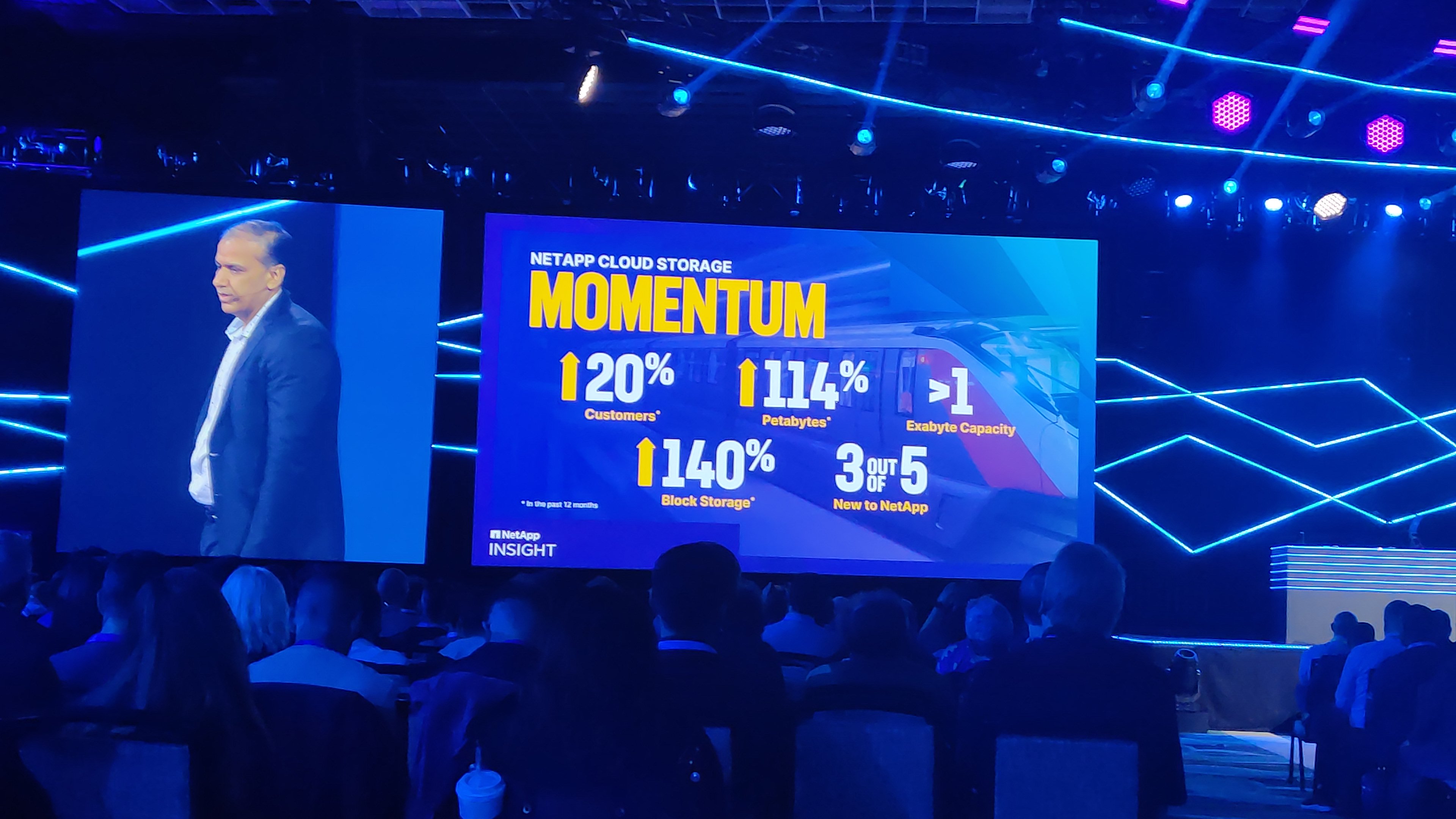
NetApps delivery engine enables the firm to boast one of the best massively caled enterprise storage service in the cloud. Offering some examples Tiwana refers back to Coke Japan which he says weer able to reduce their cost by 30% using NetApps cloud storage solutions.
Another Japanese customer, Fujifilm were able to achieve 55% savings in their cost when moving from on prem DAS to Azure NetApp files for their services in the cloud.
AI gets a mention, of course. Tiwana adds that NetApp's generative AI toolkit gives businesses the chance to learn how to create RAG-based applications in minutes using the LLM model of their choice against a proprietary dataset.
Tiwana says the most exciting part of their AI story is that the company is deeply integrating their one piece storage service with each of the hypercsler's AI stack.
Tiwana says the most exciting part of their AI story is that the company is deeply integrating their one piece storage service with each of the hyperscsaler's AI stack. AI agent builder to build applications in no code or low code environments."s
Cost is a major concern for businesses using the public cloud. ONTAP is known for cost optimizations, compression, authentic provisioning, Tiwana states, with all of these capabilites available in their cloud services.
NetApp will continue to reduce the minimum threshould for NFS and SMB volumes and the minimum capacity pool he states.
"Cost should never be the reason for not using our first party cloud services", Tiwana declares.
Now Tiwana gives way to Bhela alongside Sameet Agarwal, VP of engineering for storage at Google Cloud, who will be talking about the launch of their coengineered Google Cloud NetApp Volumes (GCNV) solution.
We have launched a very large number of capailites in the last 12 months, Agarwal says, rapidly enabling many workload businesses might need, from VMware to Kubernetes.
He says that in a matter of months over this summer Wayfair online furniture sales platform which was able to complete a full migration of their SQL backup 4 times faster using Google Cloud NetApp volumes in their migration journey.
The partnership has truly gone to the next level in the last few years Agarwal says. Although they really wan tot help customers transition to the cloud to transform their business, we can't forget about onprem workloads, bring them on to Google distributed cloud (GDC)
These are services that you can run in an air gap and manage standalone, as well as run in data centers and edge locations. We could not have been successful with GDC without NetApp and he thanks Bhela and co for their help on this.
Looking forward Agarwal says he is really excited about bringing Google's analytics smarts combined with enterprise data storage to enable new functionalities.
Google Cloud have been working closely with NetApp on how to bring them Vertex AI agents grounded on their enterprise data.
Agarwal says he can announced that this year they will be able to make NetApp Volumes the first class data store in Vertex AI.
So if you have any data in NetApp anywhere, on prem or Google Cloud, all of that data is available for the customer to use with all the AI toolkits and platforms that Google has. Pretty impressive.
Bhela says goodbye to Agarwal, stating they have covered two of the inteligent data infrastructure pillars but now it's time to talk about the services that bring the data held in these storage solutions to life.
Here comes Haiyan Song, EVP of cloud operations. Song asks how do you operationalize the data infrastructure to get the best value out of it, and this is where intelligent data services come in.
Intelligent data services covers data service and infrastructure and workload services, Song explains.
CloudOps is no longer a standalone portfolio Song says, and is now part of NetApp's intelligent services family.
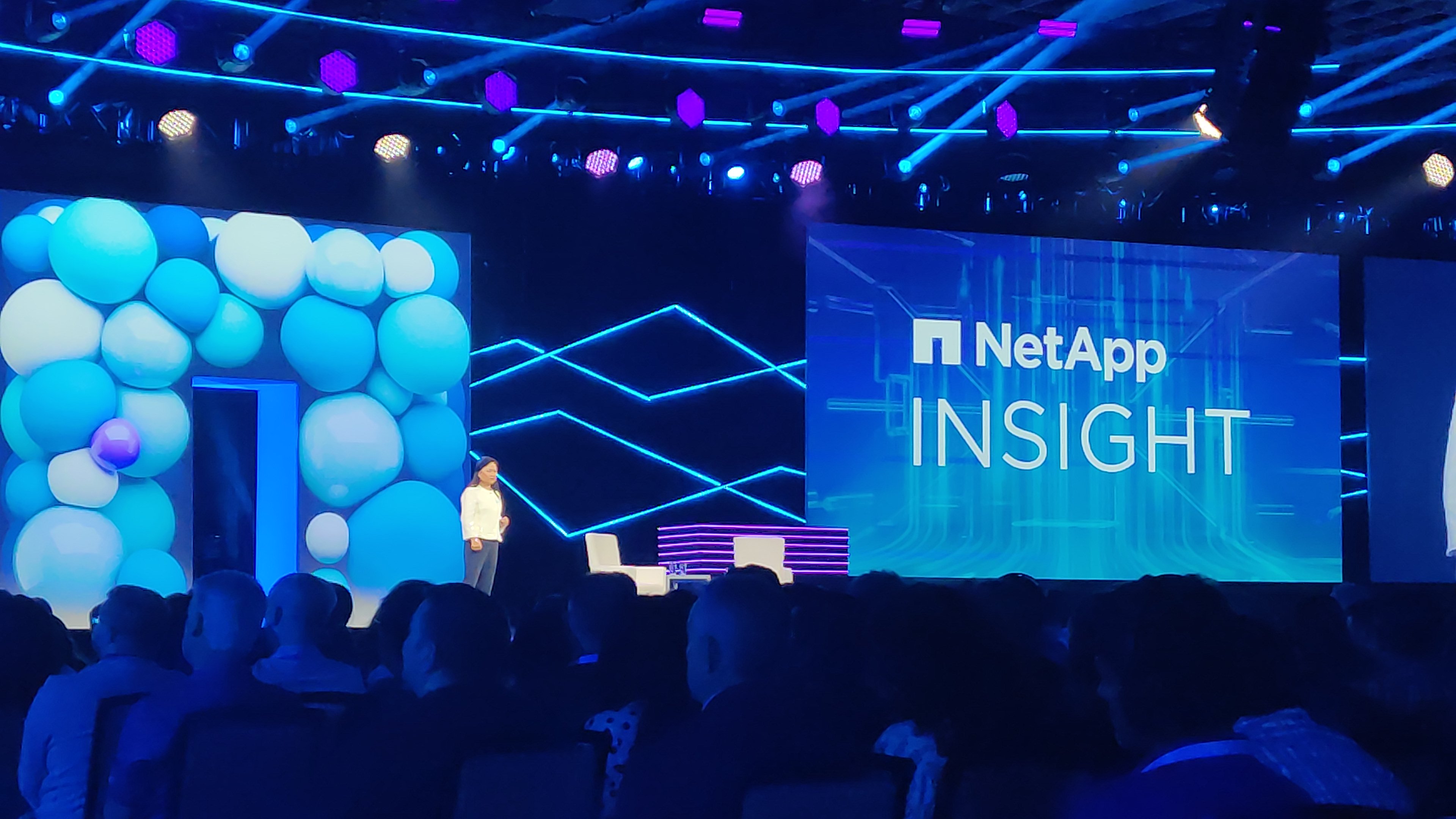
As they scale, businesses will be able to use the services comprised under this umbrella to bring automation and continuous optimization of the infrastructure for their mission-critical workloads.
As an example, Song discusses open source an area piquing the interest of an increasing number of businesses. NetApp now supports two new open source solutions, ClickHouse and and Valkey.
Focus on data centric open source and helping businesses that don’t have expertise in the area. Providing services all the way to fully host and manage open source systems that underpin mission-critical functions.
NetApp offers a unique proposition compared to the hyperscalers, providing what Song describes as true enterprise-level support, meaning response and SLAs come in minutes, particularly important for mission critical solutions. Another factor is that most businesses aren’t just using one open source solution, they have a combination and don’t have time to go to five different companies. NetApp simplifies this by giving businesses just one place they need to go for support.
Song also announces they are rebranding their Cloud Insight arm to Data Infrastructure Insight, which can provide realtime polity for SAN solutions, NetApp Advisor for ASA, which is about real-time topology for SAN systems.
This is a simple but powerful service, Song adds, stating that NetApp are for the first time releasing a new data infrastructure insight feature in tandem with new blaock storage products.
Now back to Keystone as Singh promised. Song announces that NetApp is now offering data infrastructure insight as a subscription offering within Keystone.
She summarizes that intelligent services play a key role in building and operating an intelligent data infrastructure.
Now the crowd welcomes Gagan Gulanti, VP and GM of data services at NetApp who wants to talk about security in regards to storage.
He notes this year NetApp were one of the inaugural firms signing the US government's secure by design pledge, which receives a big cheer.
Today NetApp are bringing out integrated ransomware response and recovery features in their ONTAP architecture, as well as BlueXP, this is NetApp ONTAP Autonomous Ransomware Protection with AI (ARP/AI).
This makes them the first storage vendor to bring real-time ransomware protection Gulanti notes.
This is now generally available and leverages AI to gives businesses what it claims to be 99% accuracy for detecting ransomware threats. Customers can use ARP/AI to monitor abnormal workload activity and automatically snapshot data at the exact moment an attack occurs, so they can respond to and recover faster from attacks.
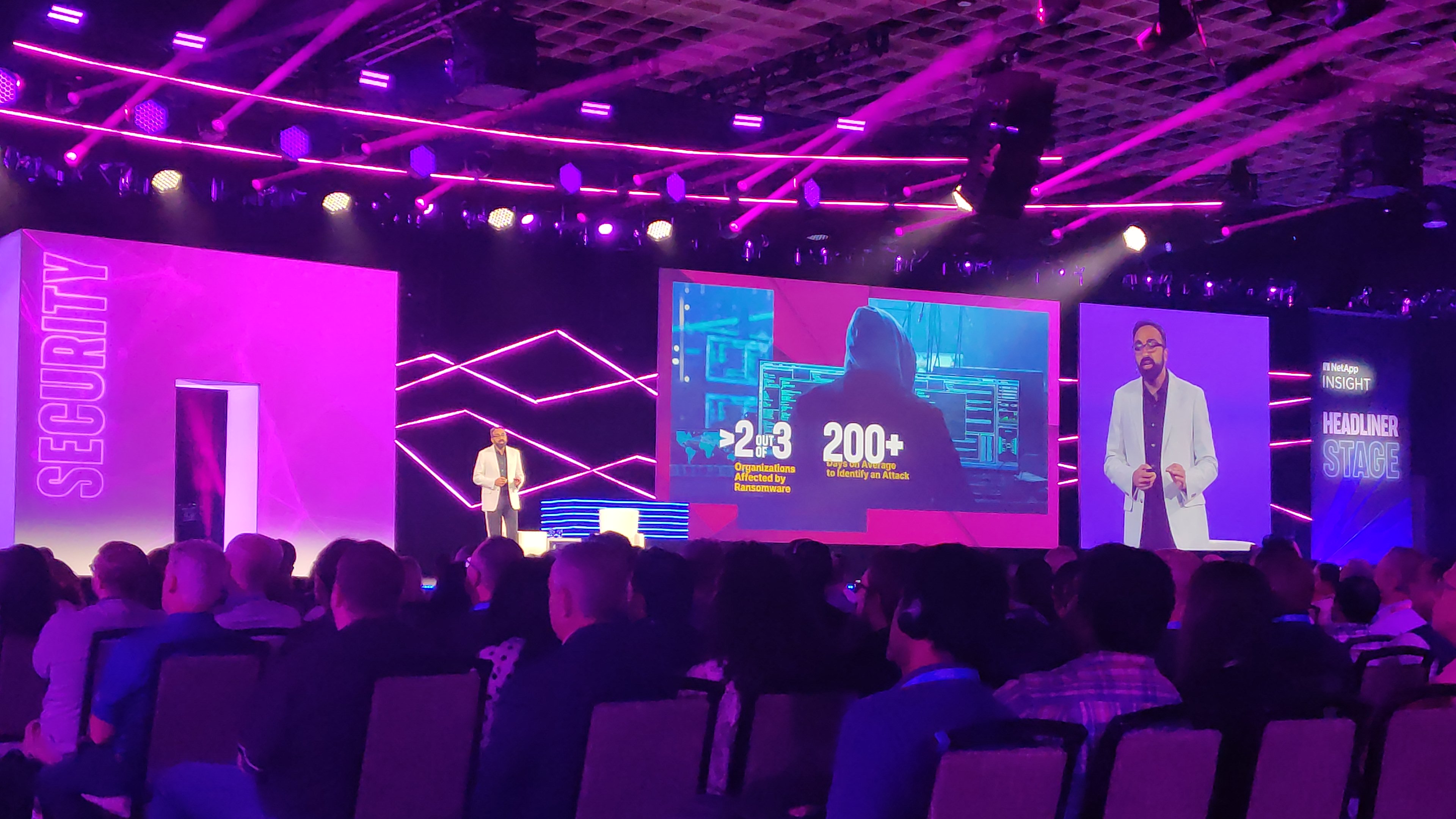
Gulanti adds that NetApp will be providing automaitc updates to these ARP/AI models in ONTAP without customers having to upgrade ONTAP itself.
Gulanti is now walking through exactly how this works, where NetApp gets daily feeds of the latest ransomware attacks being launched by threat actors around the world.
NetApp's researchers add these new attacks to their model streams to the existing mix of training data, and retrain their detection models. Once they are effective in protecting against the latest attack techniques, NetApp pushes these to customer ONTAP systems, "and that my friends is magic" Gulanti shouts.
BlueXP also now integrates with Splunk SIEM to simplify and accelerate threat response by keeping security stakeholders across an organization continually in the loop, Gulanti adds.
He is now going through a demo of how a SOC operator can move through the recovery process in BlueXP after getting an alert in their Splunk SEIM.
The system automatically recommends the best snapshot to restore from, and this could be a mixture of snapshots from different points in time, depending on how data was exfiltrated from the environment.
Customers can choose to restore the affected app, in this case, to a new location while the security team continues to investigate the attack in a different location. This should help businesses minimize downtime after they experience a ransomware attack, and helps prevent security teams rushing through the remediation process which could risk missing malicious elements on the network.
Gulanti says instead of just telling us why this important, he wants to show us, and cues a DreamWorks video reel.
Haiayn Song is back on stage with Bill Ballew, CTO at DreamWorks to talk about how NetApp has used intelligent data infrastructure and workloads services to help their applications run with better perforamnce.
The video reel appears to have been for a new film called the Wild Robot, and we are treated to a trailer.
After that's done we are back with Song and Ballew, who are talking about how CG animation is ultimately a data businesses, with many multifarious streams feeding into one system from a wide range of distributed sources.
Ballew says DreamWorks used NetApps solutions for data storage which has been the foundation of their production workflow, and on top of that foundation DreamWorks leveraged NetApp's intelligent data services to achieve new functionality in terms of data visibility, management, and optimization.
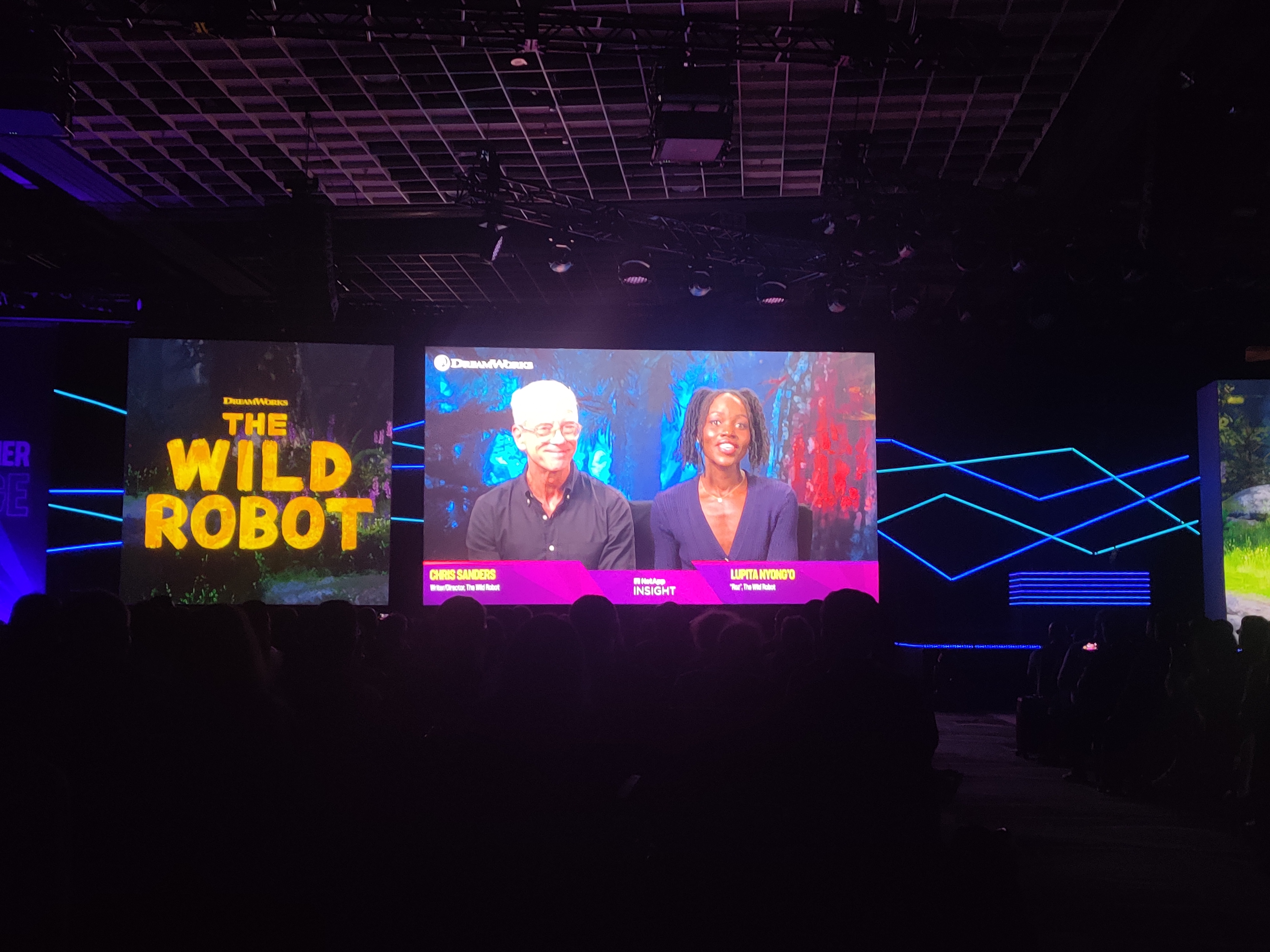
Data infrastructure insights allow DreamWorks to analyze their infrastructure in real time, generating alerts allowing them to get ahead of any issues before they become bigger problems.
He says the for just one CG animated film, they create more than half a billion digital files. so they rely on cutting edge technology to ensure their outputs are of the highest quality.
That's it from Ballew, who leaves to quite a large applause and Song passes the mic back to Harv Bhela. He says that yesterday Krish Vitaldevara, SVP and GM of platform shared the start of NetApp's AI journey and he wants to continue on this path.
He wants to talk specifically about generative AI for enterprises, which he says NetApp is uniquely positioned to help businesses harness to their benefit. One example he offers is the fact generative AI relies on unstructured data, and a very (he repeats this quite a few times) large amount of unstructured data is already in NetApp storage solutions.
Next up, he says AI is inherently hybrid, training usually in the cloud the data is usually on premises, and Bhela emphasizes NetApp's unique position to offer a seamless hybrid.
But to speak more on brining AI to the enterpise data he welcomes back Vitaldevaram this time sporting another T-shirt with the 'make data AI ready' slogan.
Vitaldevaram says the AFA-90 systems will give industry leading 1 TB per second throughput, noting ONTAP achieves this perfomance while leveraging open protocols like S3 and pNFS over standard ethernet.
Vitaldevaram announces the Nvidia certification process of NetApp ONTAP storage on the AFF A90 platform with NVIDIA DGX SuperPOD AI infrastructure to loud applause.
He then unveils that NetApp is building a disaggregated storage architecture to a similar pop from the crowd, which is built all ONTAP with all the data management features including snap mirror, flex cache and more.
He says he is confident that this really transformational change to firms' data infrastructure ready for AI and wants to hear from customers next year how this technology has transformed their AI data journey in their data centers.
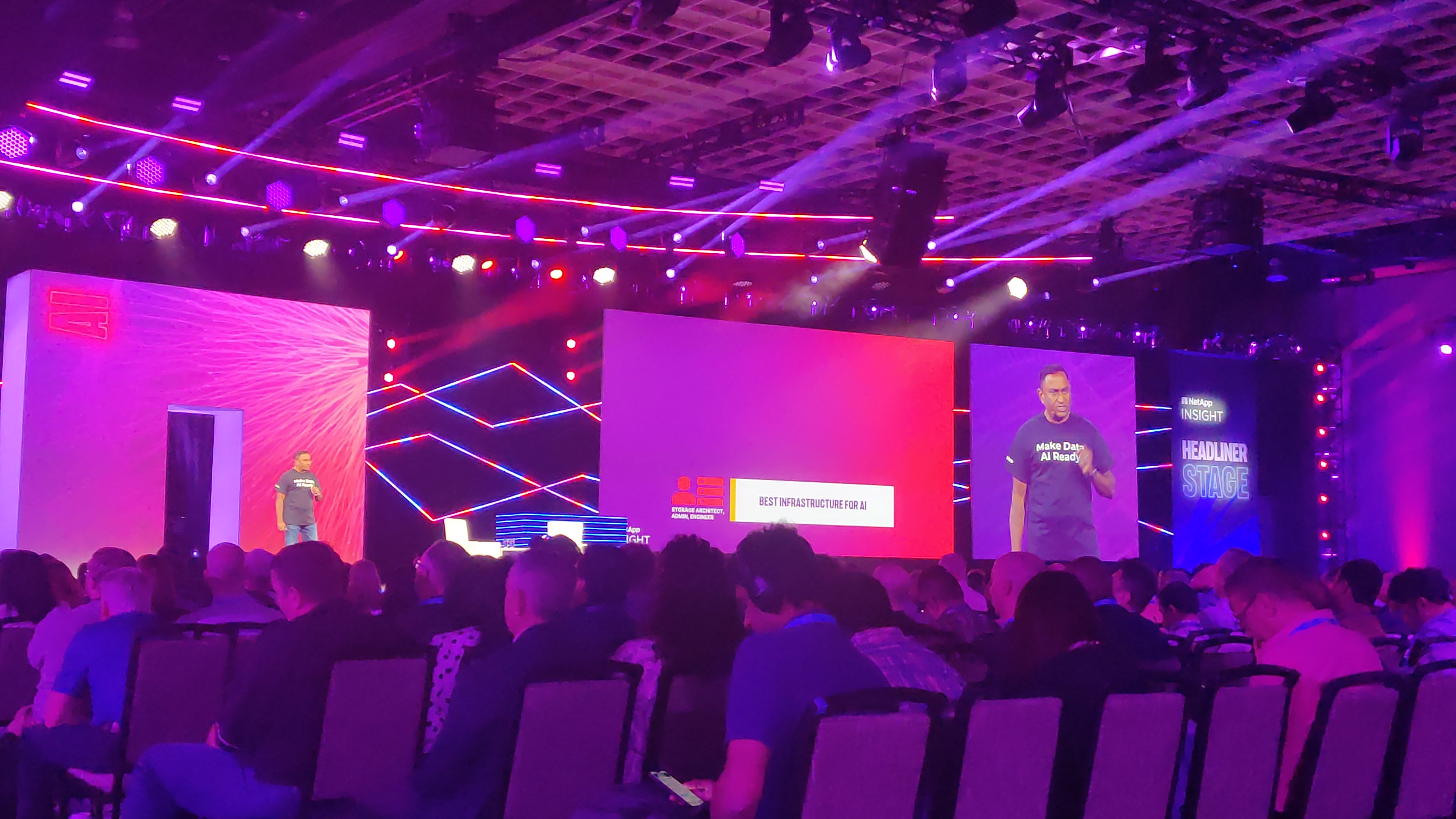
Vitaldevara harks back to the global metadata namespace he discussed onstage yesterday which brings new structure to unstructured data, stating no one else can bring AI to your data like NetApp.
Business AI workflows have a number of different operations that change the data, including embeddings, vectorizations, data classifiers. Vitaldevara says the ONTAP-isms like snapdiff can make this AI engine automatically capture changes to their data to provide firms a unified, structured view of their unstructured data.
Vitaldevara is now demonstrating how NetApp can deploy data collection directly into NetApp AI data , creatingng an optimized vecotr embedding that businesses can use for their generative AI application of choice.
He shows how this can work with Nvidia Nemo integration, their LLM playground, the tool can immediately connect NetApp's data collection using RAG, and when asked a question it will use the the data provided, in this case a doctor's notes, to come up with a summary.
"And this summary is constantly updated with newly created content, so when you add data the content refreshes"
Vitaldevara asks a different question, which the model cannot answer due to governance policies prohibiting it from giving out PII, noting that NetApp brings the customer's policy and governance rules through the whole process ensuring the model never gets to train on sensitive information you don't want it to.
Vitaldevara is now summing up the last five minutes claiming NetApp have introduced the best infrastructure for AI, he runs through the disaggregated architecture with all the data management features customers already enjoy with NetApp insight.
"We also announced a robust data engine, with a global metadata namespace and it's going to be integrated with vector databases, and thi swill help you do inferencing in a box'.
"Hopefully this wets your appetite with just a taste of all the amazing AI innovation we have planned for this year."
Vitaldevara says he hopes the audience visit the AI team's booth at the expo hall to hear more about what NetApp is doing to bring AI to enterprise data wherever it may be before handing back to Bhela.
Things are wrapping up here on day-two at NetApp Insight 2024, Bhela is rolling through everything we've heard today, from the updates to NetApp's block storage line, its security features, and the strides its making in AI.
He stresses that NetApp has achieved this using one common architecture, meaning no silos that require extra resources to circumnavigate, or costly reengineering to break down, "you get way higher ROI from investments in us."
"Thank you for trusting us with your data" Bhela says before handing back to Mario Armstrong to bring the ceremonies to an end.
That's it for today, make sure to tune in tomorrow for ITPro's rolling coverage of all the exciting developments on the final day at NetApp Insight!
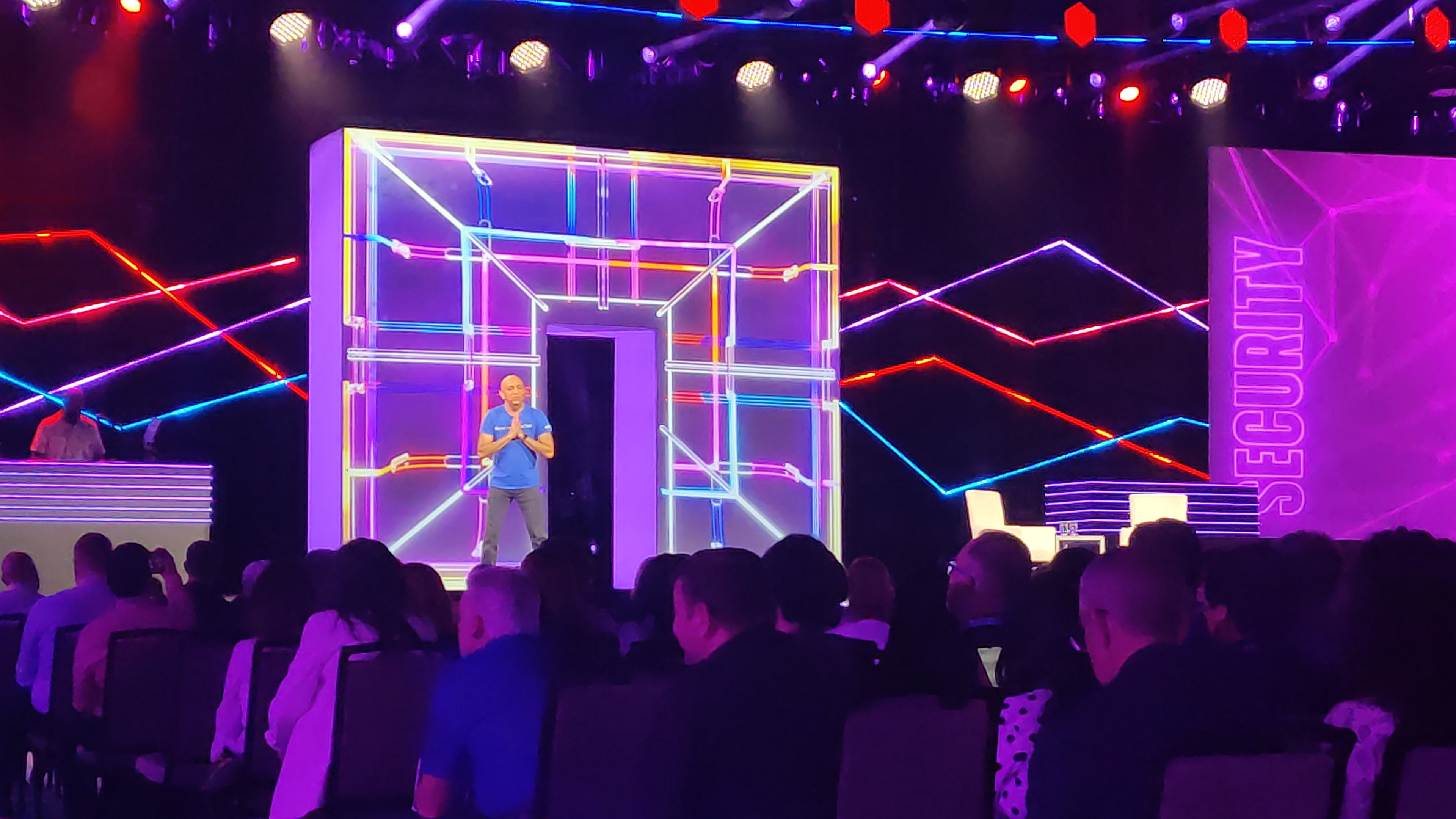
Yesterday we were treated to a raft of product announcements, including new additions to NetApp’s block storage portfolio, as well as updates on the latest AI-focused features the company is rolling out in its newly dubbed intelligent services arm.
Today we will be hearing from César Cernuda, president of NetApp who leads the company’s go-to-market strategy and execution, as well as Jenny Flinders, SVP of NetApp’s worldwide partner organization.
We have been informed Hoseb Dermanilian, senior director and global head of AI go-to-market and sales at NetApp, as well as Jonsi Stefansson, SVP and CTO, will also be presenting today.
There will be a number of NetApp’s partners and customers also taking the stage, including Nvidia’s VP of global AI solutions, Matt Hull to talk about their work together. We will also be hearing customer stories from medical organizations such as the European Institute of Oncology and the US-based Monument Health.
The agenda is packed so be sure to follow along to stay up to date on what NetApp has been up to in the last 12 months, and what’s to come in the years ahead!
The closing keynote is set to take place at 10am PT. While we wait for things to get started, why not check out some of our coverage from the last few days action.
● NetApp could corner AI infrastructure at Insight 2024 – but customer hype will ride on its messaging
● NetApp eyes AI capabilities to tackle growing ransomware threats
The conference center is fairly quiet at the moment, with just a sprinkling of delegates getting their breakfast and coffee before the final day get's started.
Perhaps the slow start has something to do with NetApp's Insight Encore party taking place last night...
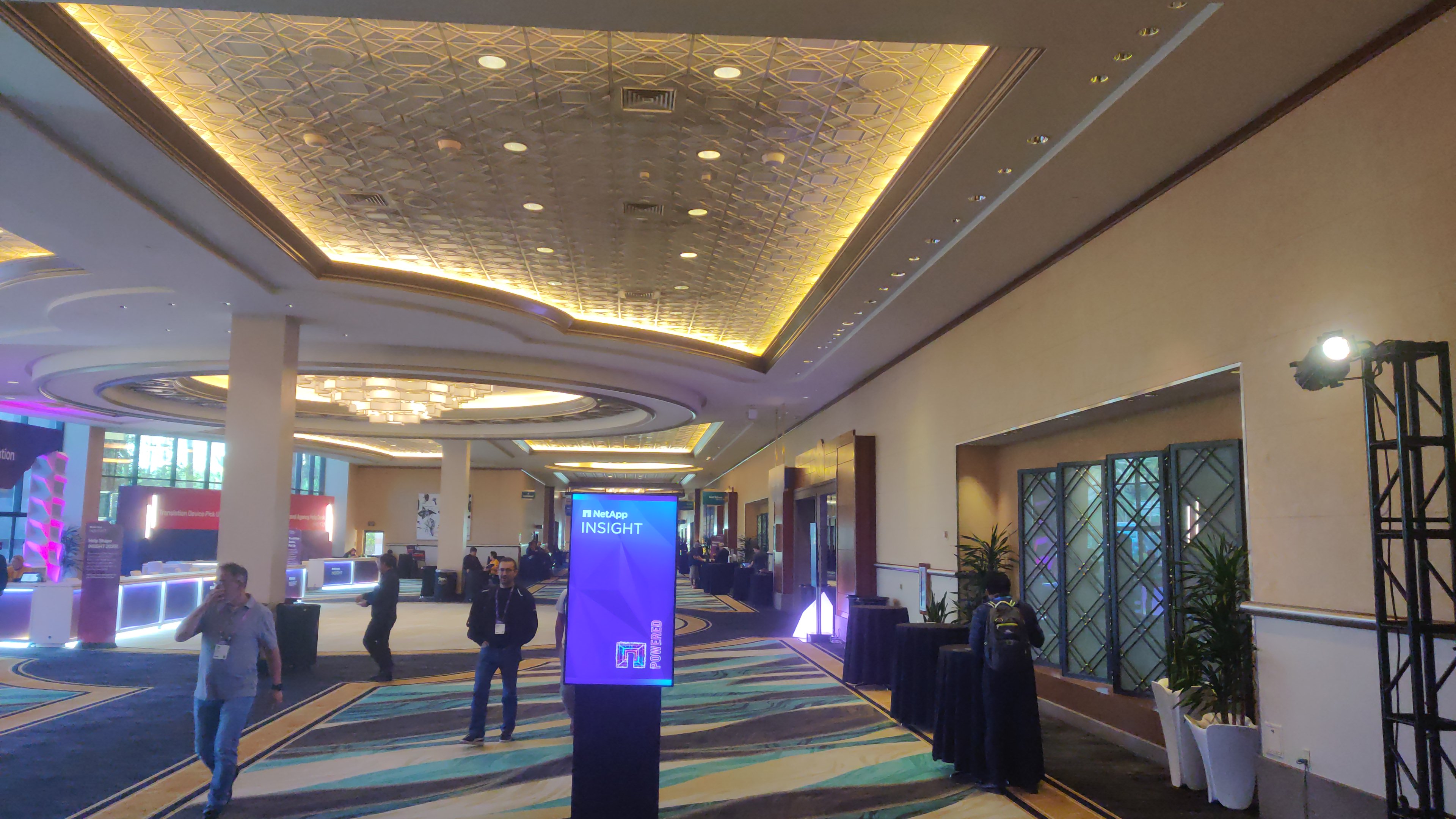
In the main lobby area, the Google Cloud DJ is still hard at work, a valiant effort from him over the last three days.
Opposite the DJ booth a graffiti artist has been working on a NetApp mural over the course of the conference, here's a shot of him yesterday.
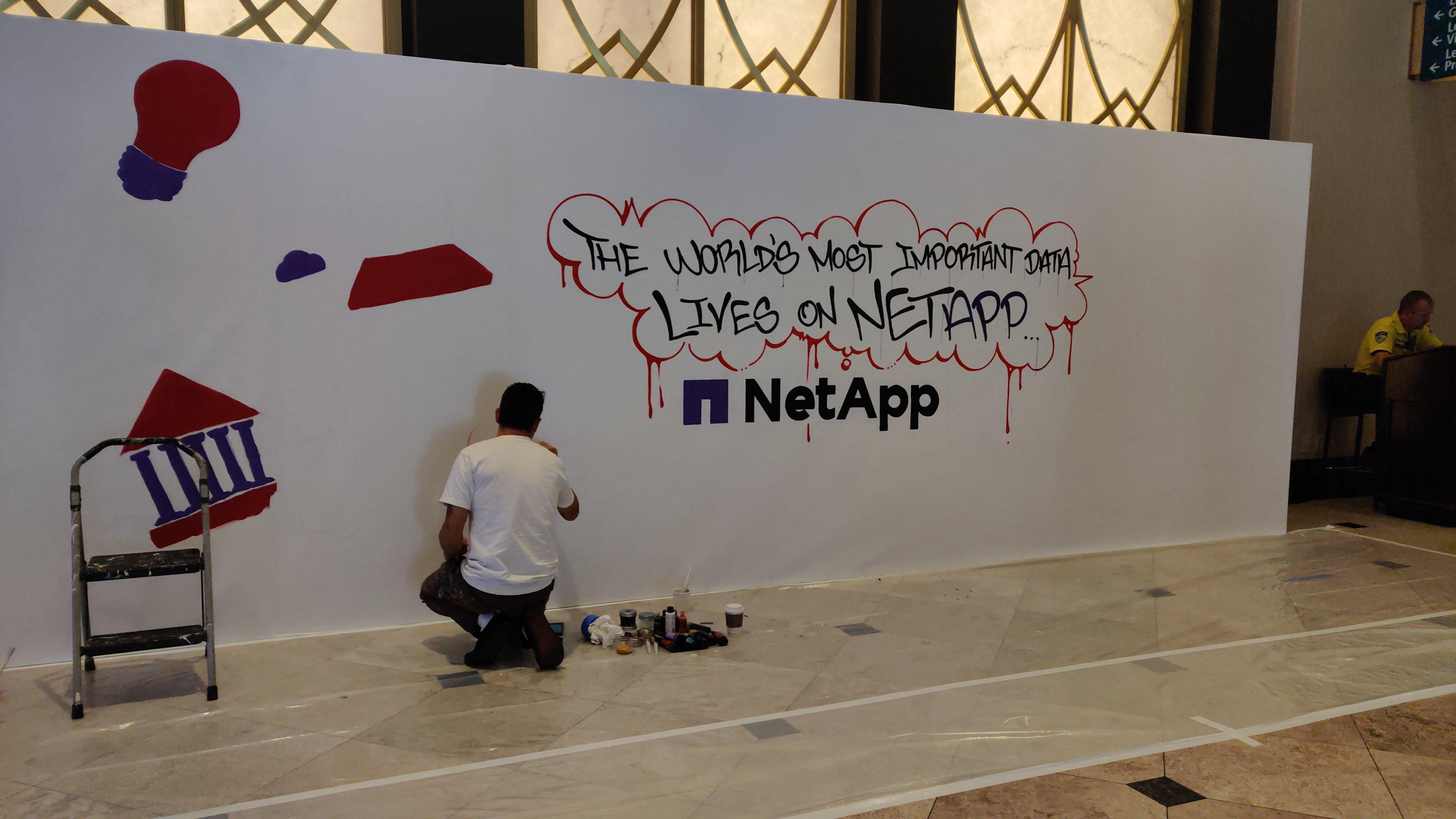
And here's an update on his progress, We think we saw some other artists working on this yesterday so perhaps it's a joint effort. The masking tape suggests it is not quite finished, so we will have to keep you updated with a photo of the finished article.
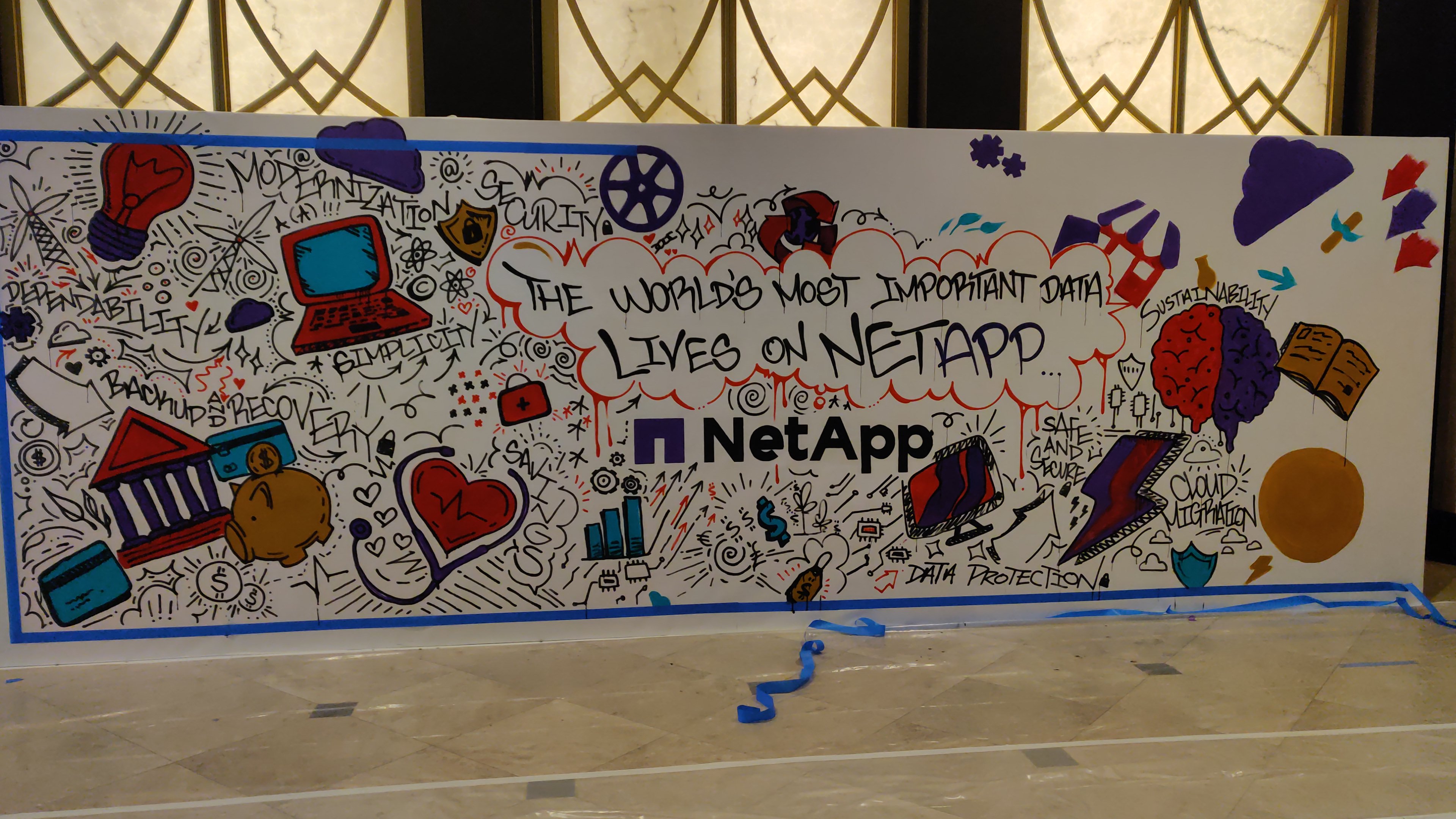
Things are starting to pick up and the crowds are growing in the waiting area outside the headliner stage, ready for proceedings to get underway.
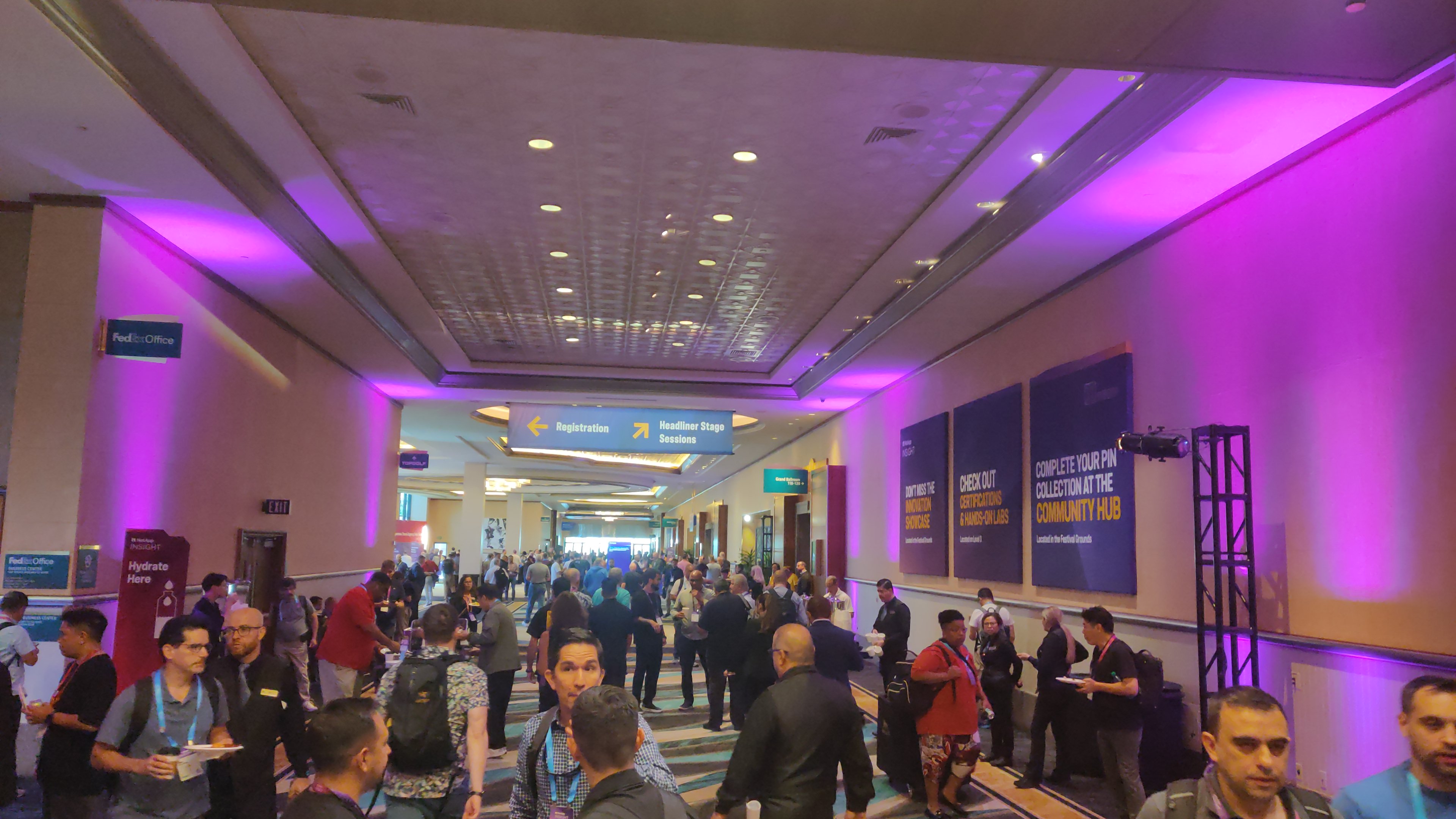
Eventually we are let into the keynote arena, and as if he know some attendees are a little worse for wear after last nights party, DJ Graffiti has forgone the high intensity club mixes for Tracy Chapman's Fast Car.
Well that was short-lived, he's quickly transitioned back into the heavy stuff and some Beastie Boys.
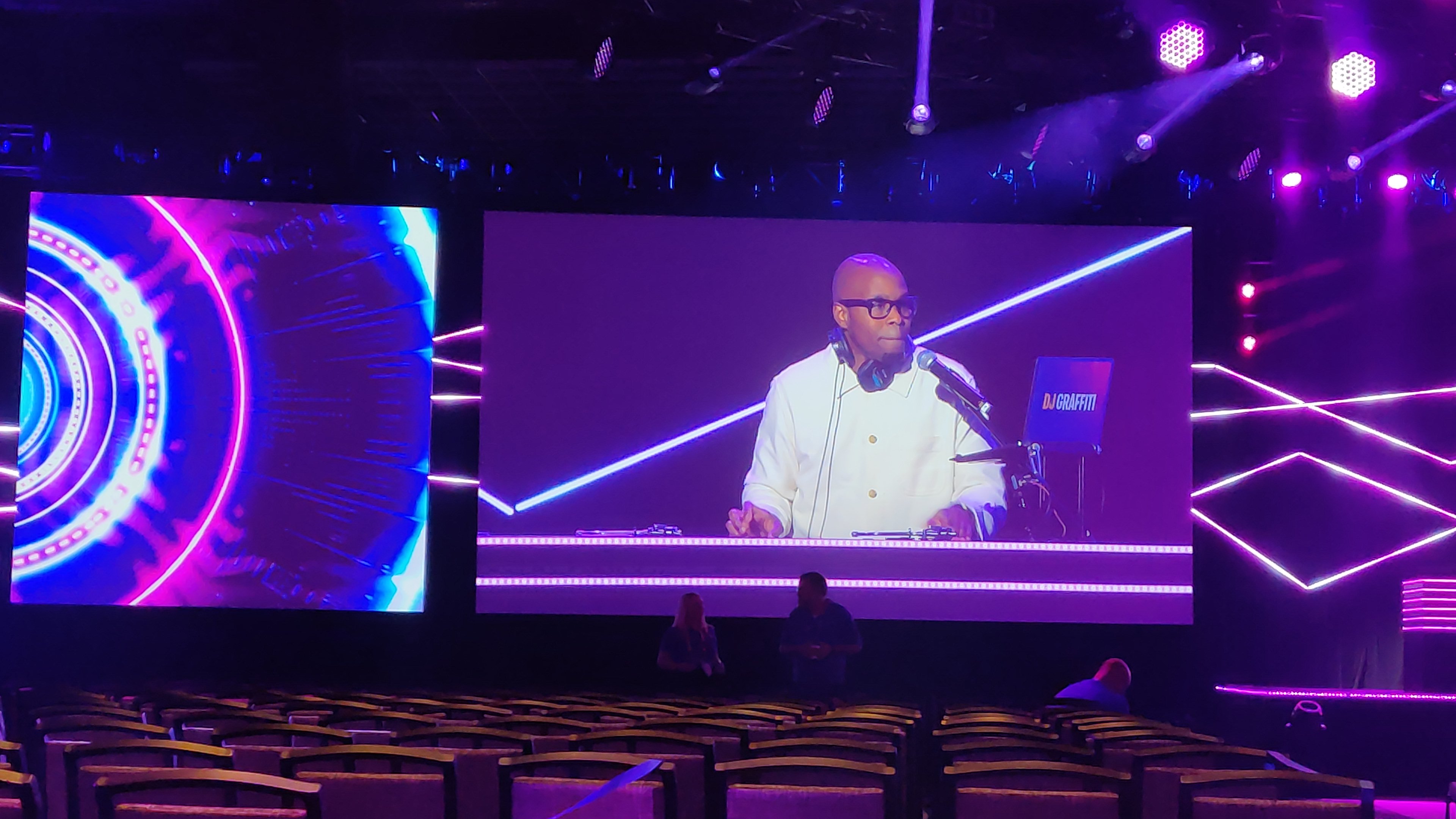
There are still quite a few empty seats here in the auditorium with just 10 minutes to go before César Cernuda takes the stage, as the audience continues to stream in.
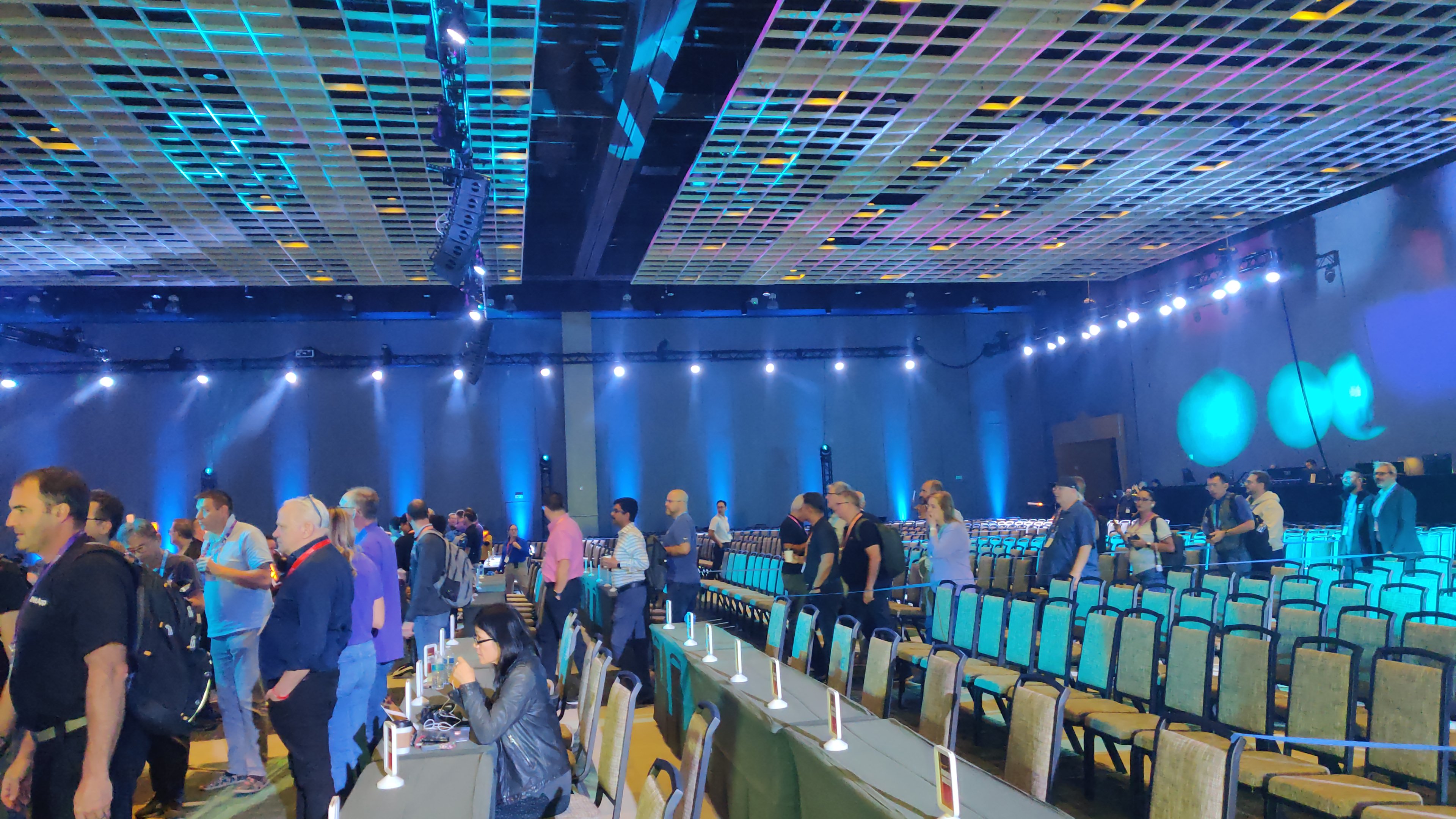
We're almost there, just five minutes to go before we get started, our host Mario Armstrong is interviewing some of the delegates, asking how they've found this year's NetApp Insight conference, all glowing reviews so far.
The keynote arena is almost full, with an impressive final day turn out, as Mario turns things over to the usual high-gloss show reel to get things started.
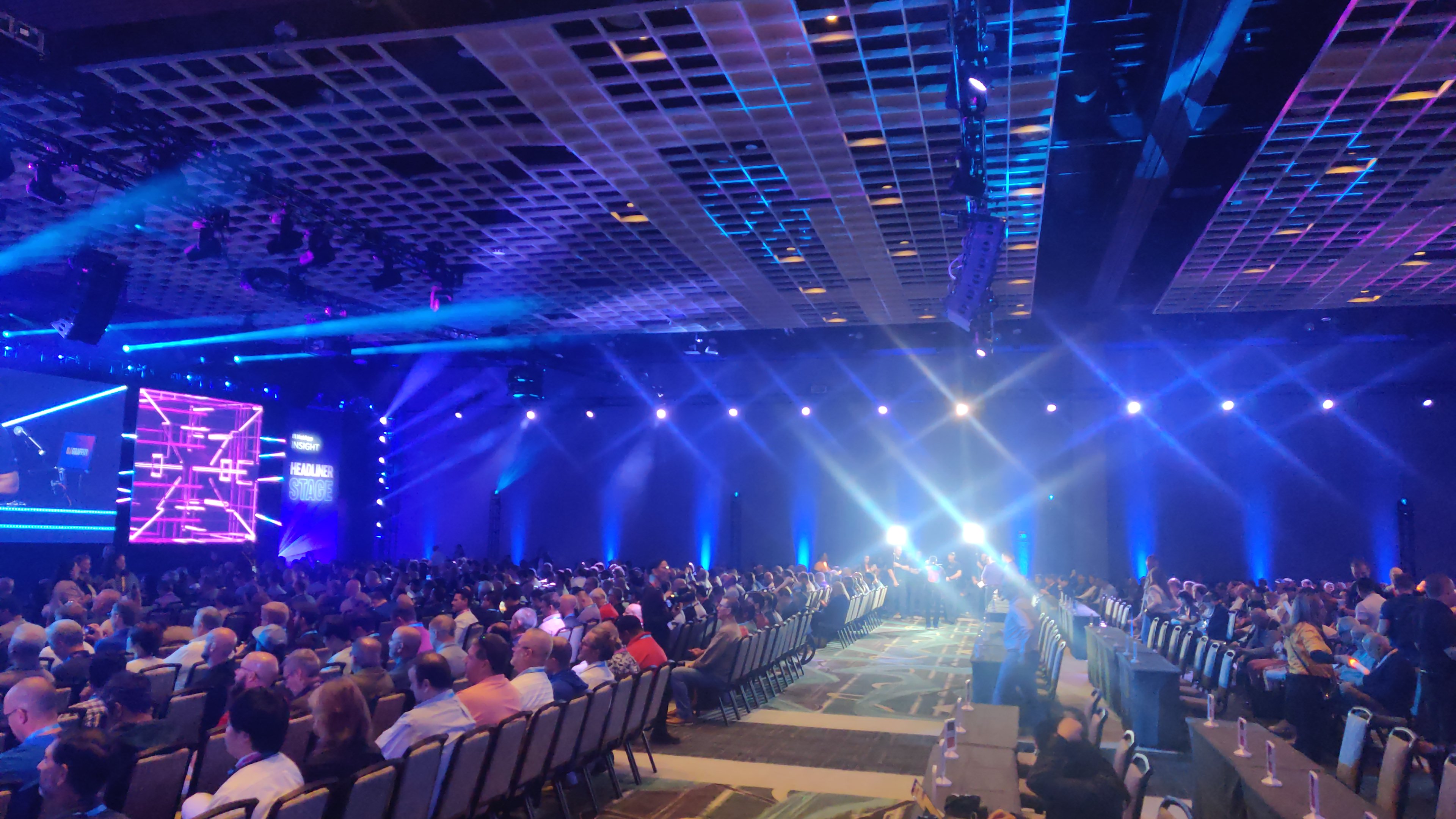
Mario is on stage now welcoming all the attendees and he's clapping it up trying to get some energy going in the room. The crowd participation is going... okay. But now he welcomes NetApp president, César Cernuda to the stage.
Cernuda is running through some of his highlights from the event, with a little collage of photos from his time at the conference. He emphasises that he wants to thank the attendees for their presence, their trust, and the most important asset they have: their data.
This is a responsibility that Cernuda says they don't take lightly.
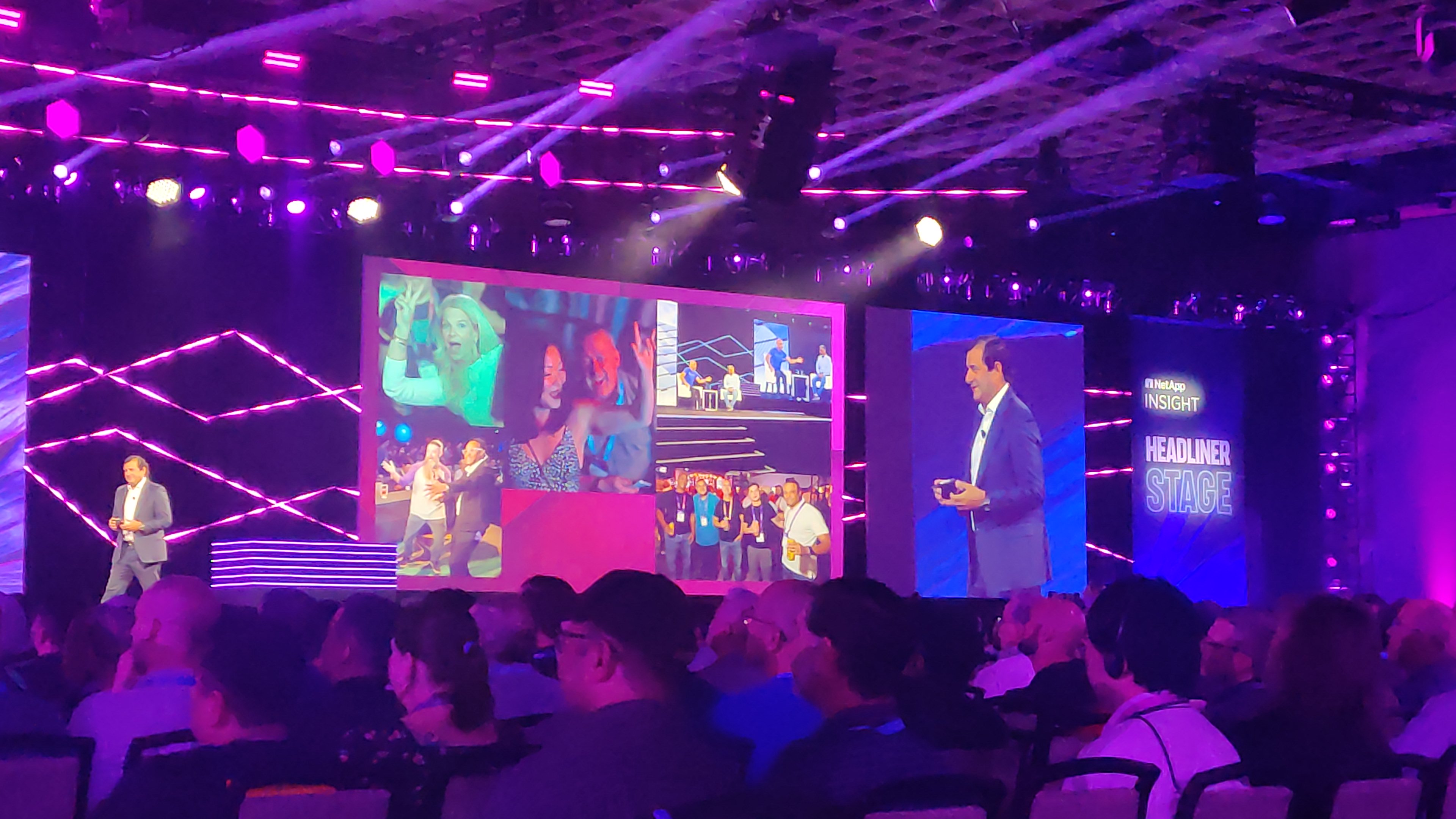
Cernuda sets off on a recap of some of what he've seen this year at NetApp Insight 2024, starting with CEO George Kurian's opening address, setting out his strategic vision for NetApp as an intelligent data infrastructure firm in this third stage of the modern data modernization.
Cernuda says he hopes the audience can see that NetApp is consistently innovating to stay ahead of the ongoing AI boom. He touches on some of the product launches from yesterday's presentation, the new ASA A-Series storage solution gets a nice cheer from the crowd.
He moves onto Krish Vitaldevara, SVP and GM of platform's presentation on disaggregated storage which he says is the future of infrastructure that will inderpin high performance AI workloads in years to come.
Cernuda wants to come back to the overall picture of NetApp as an intelligent infrastructure firm, showing a infographic that illustrates how all these pieces come together to realize this vision.
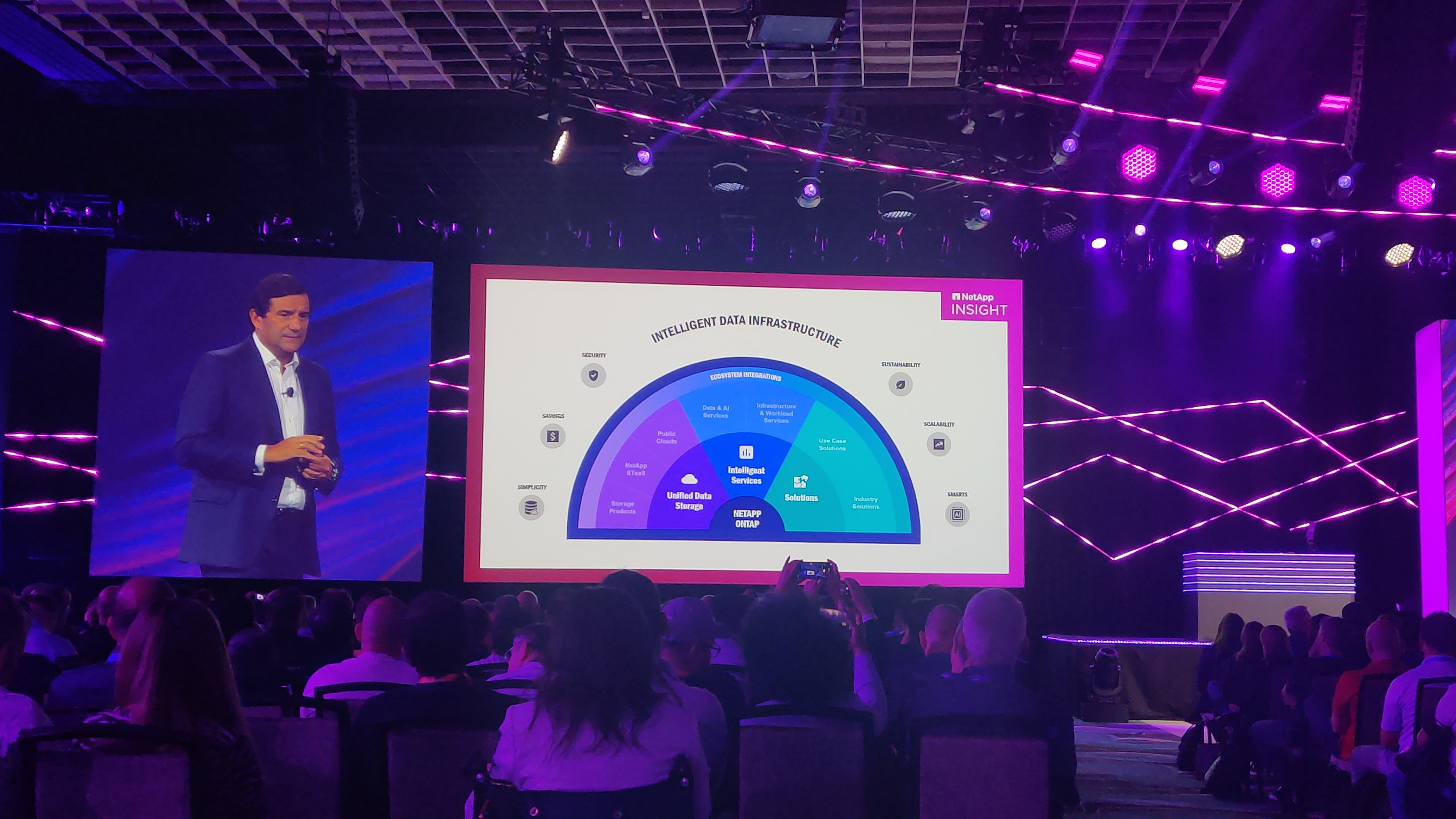
After running through a brief summary of what we'll be seeing today, Cernuda is talking about how NetApp thinks about AI-enabled customer success.
This includes providing proactive support, listening to customers to provide easier, simpler, and a streamlined experience, he says. Another part of this equation is NetApp's Active IQ, it's digital support service.
AI Ops in NetApp's BlueXP control plane for its ONTAP data architecture is another feature that brings predictive health monitoring to lower TCO.
Cernuda says NetApp's Keystone storage as a services offering is also vital to maximizing customer value and increasing agility.
That's it from Cernuda and he introduces Hoseb Dermanilian senior director and global head of AI go-to-market and sales at NetApp.
Dermanilian says the AI journey he wants to talk about today has been six years in the making, and he is proud to have been part of this journey from the very start.
Dermanilian says that intelligent data infrastructure is more about just storing data at super fast speeds, its about having the capability to understand your enterprise data “intelligent'.
He is runnning through some examples of what this actually means in reality. First ensuring data access is seamless, providing businesses with a single copy of their data, with data scientist having their own version that they can work on.
He says that at one retail customer was able to turn down costs by reducing energy, cooling power, and wasted capacity. This saved thousands of dollars, Dermanilian says.
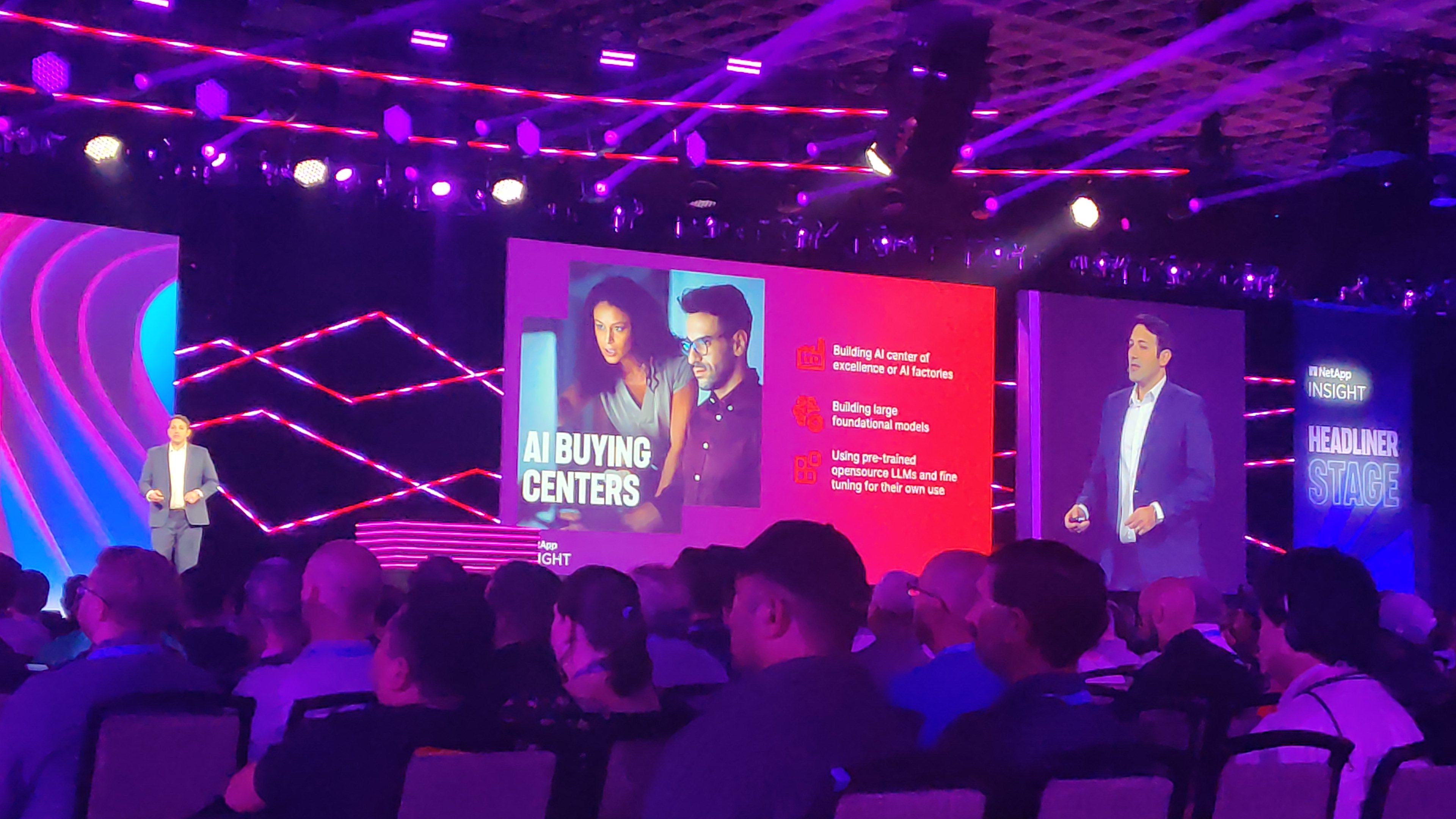
To make things a little more real, Dermanilian introduces Matt Hull, VP of global AI solutions at Nvidia, here to tell his point of view on what's happening in the AI market today.
He says the past two years have been very exciting. But he says right now we are at a sea change where experimentation evolves into actual workloads at enterprises. "The next two years of artificial intelligence will look very different to the last two".
Moving experimentation into the enterprise means businesses have very wide ranging use cases that they need to apply AI to, and that's where Nvidia and NetApp's partnership is so important to bring the things enterprises need to do to AI.
Speaking about NetApp's SuperPod certification, Nvidia is able to bring the entire AI factory at the SuperPod scale down to BasePod level solutions to their enterprise partners.
Dermanilian notes that Jensen Huang CEO at Nvidia singled out NetApp at their GTC conference earlier this year, and Hull explains that this was because NetApp has been a leader in the data infrastructure for AI since day one.
Data movement and data strategy are going to be extremely important Hull says, and NetApp will be a critical partner on this journey, he says.
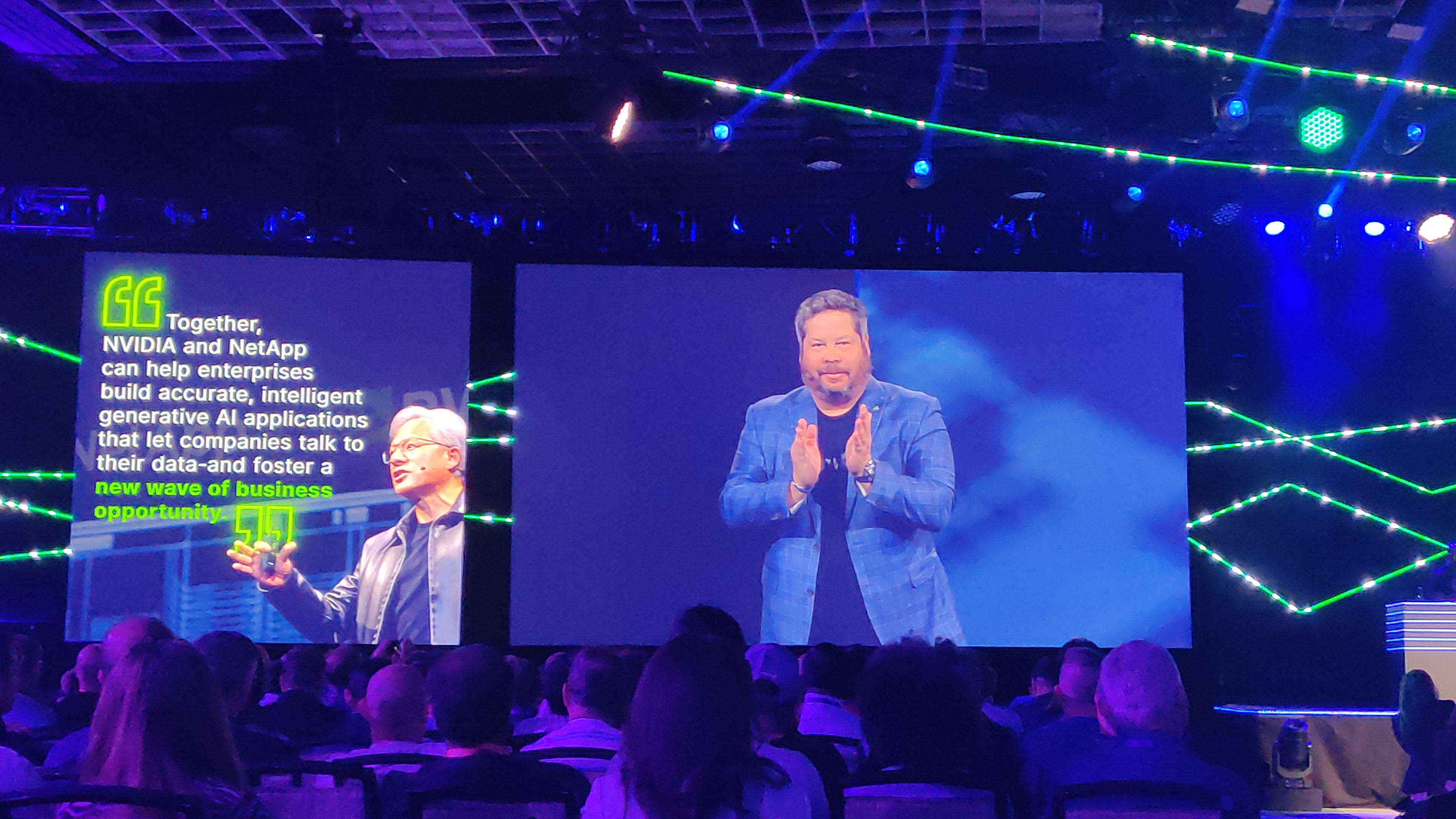
That's it from Hull and Dermanilian, and we are now joined by Jonsi Stefansson SVP and CTO at NetApp who wastes no time getting straight to it. He says NetApp fundamentally believe that AI is going to stay hybrid forever, a mix of on prem and cloud to get the best of both worlds.
He dives into a demo showing data ingestion and training using Domino Data Labs, who NetApp have deep integrations with, as well as other ecosystem solutions like Kafka.
He says "whatever cloud you want to work with NetApp has your back."
But now with a model its time to put it into production. Stefansson says maybe you're pinning this model back from the clouds to on prem, businesses can choose from designs with RedHat, OpenShift AI, Kubeflow, and more to make their AI projects ready and available.
For those who need help, NetApp will also offer Instacluster as a managed service for key pipeline components such as Kafka and PTvector.
"Make no mistake with intelligent data infrastructure, you get rid of data silos, accelerating business values, simplifying your data environment and most of all, de risking the implementation of AI."
That's it from Stefansson, and Dermanilian is back running through all of the features, capabilities, and integrations that customers have asked for and NetApp has delivered: disaggregated architectures, Nvidia SuperPod certification for ONTAP, metadata engines, and more, and all of this is delivered with a single unified architecture with no silos.
This gets quite a big cheer from the crowd.
Dermanilian welcomes NetApp president Cernuda back on the stage who cues a video introducing our next guest Annarosa Farina, CIO at IEO, the European Institute of Oncology.
Farina says she's been working in healthcare for more than 20 years, always focussed on process optimization through technology, system integration, always at war with application silos, and above all on data integration.
She says she is currently the game changer at the IEO driving it into a data-driven company. She runs through the most important changes she is seeing in healthcare technology.
First up is AI-assisted diagnostics, she says healthcare is very much process driven, where standardization is key to safety which is a vital principle for any healthcare institution. Ai allows healthcare instirutions to create models which can provide practitioners with outcomes that are evidence based.
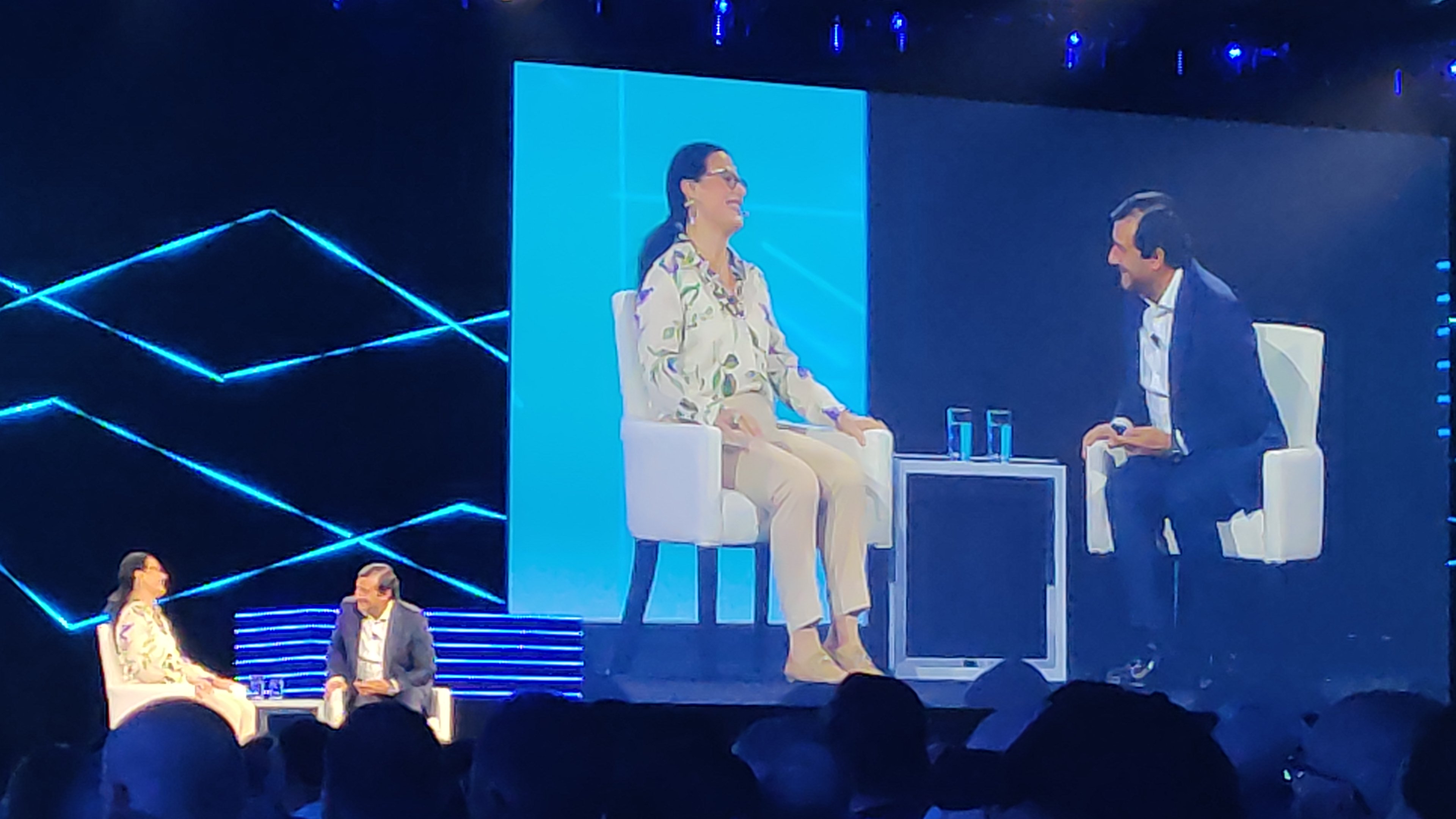
Farina is now discussing her organizations work with Google, using Vertex AI to and train proprietary models, which was finalized in just 46 days and allowed the organization to transform 76,000 unstructured reports into structured data sets, allowing for 300 times faster than the previous manual process.
"This means were able to collect this data at the point of care, which is faster, and also accurate actionable data collection."
On some of the challenges she is facing, Farina says the language barrier continues to be a problem, which means that some of the models they are developing are not at the point they wish or need them to be at. As a result she says her organization tends to train smaller models so they can govern the quality of the outputs better.
Cernuda thanks Farina for sharing her thoughts and both take their leave to some impressive record scratches from DJ Graffiti.
Mario Armstrong is back on stage who is letting us know that this is where he leaves us, and is making an early exit. But before he goes he wants to shout out the entire production team, getting the crowd to show their love, with a special shoutout for the NetApp events team.
Mario gives way to Jenni Flinders, SVP of NetApp's worldwide partner organization, who will be giving a special shoutout to some of the NetApp partner network.
Jenni Flinders wants to give a quick tour of from three areas in the world where there partners are doing 'great things'.
These include XPANSE Party limited in Australia, CDW in the US, and the Saudi Telecom Company.
"Each one of these stories are just a subset of a larger picture of hundreds and hundreds of similar cases with customers around the world", and now Flinders will be announcing the winner of NetApp’s Partner Innovation Award.
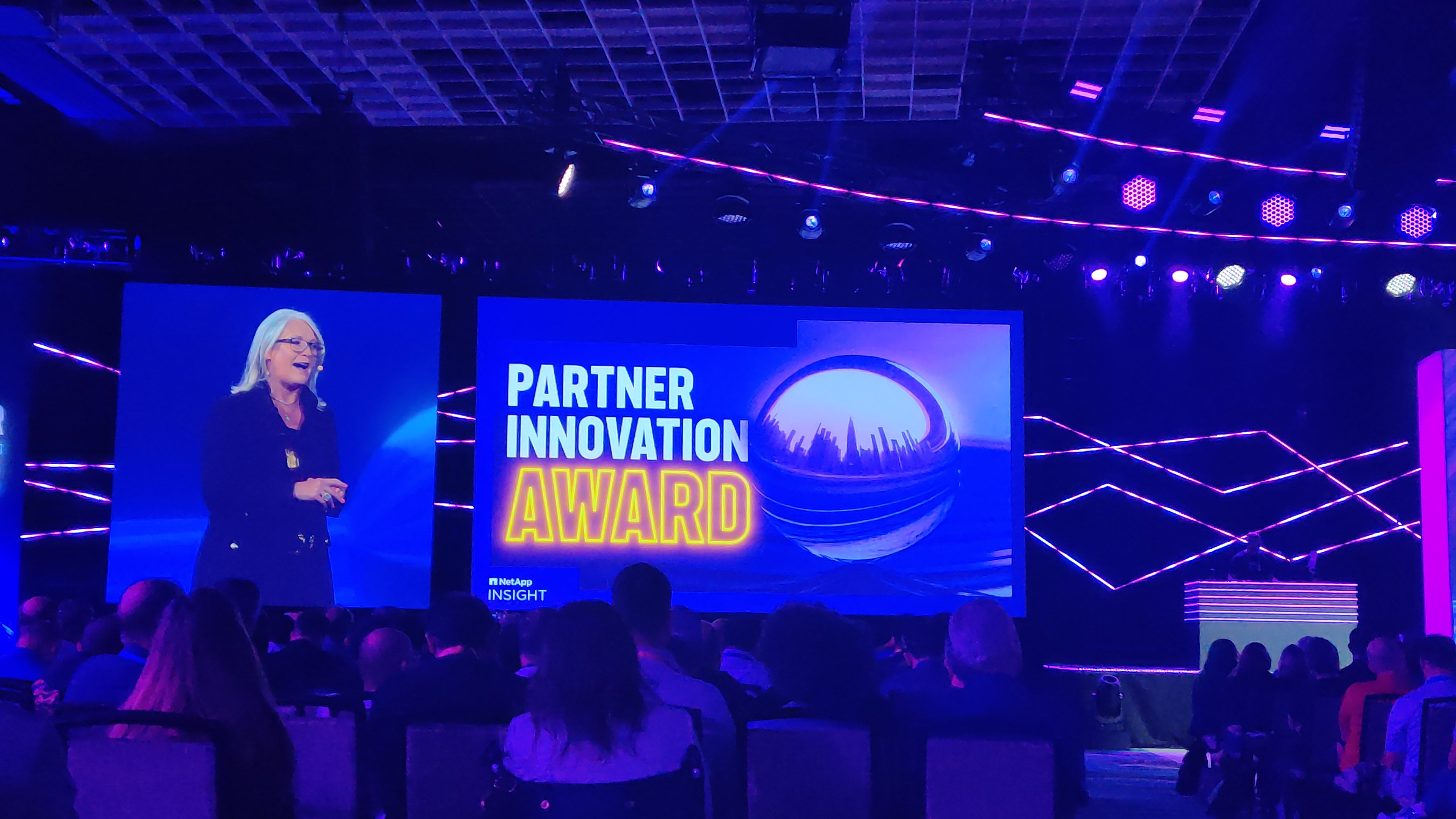
This year's winners are IT service management firm CDW and their customer Monument Health.
Flinders welcomes Clint Oyler, senior systems engineer at Monument Health, and Travis Rubida, principal consultant at CDW.
Their story comprises helping Monument with their migration of their EMR system to EPIC, one of the most widely used electronic medical record applications in the world.
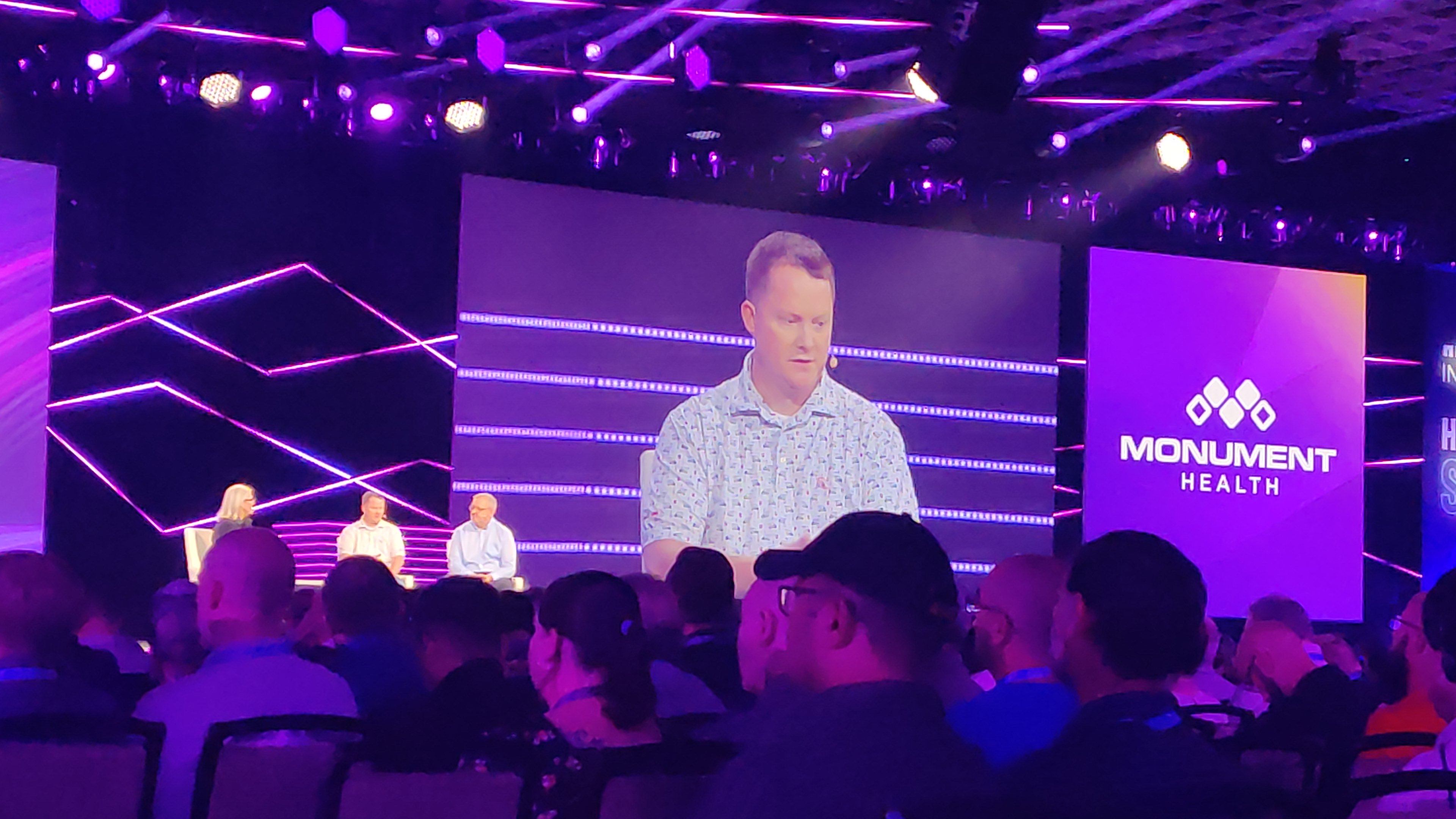
After a quick picture for the winners CDW and Monument Health, César Cernuda is back on stage to take us home.
Cernuda rolls back through some of the names we've seen on stage over the last three days, Johnson & Johnson, the Institute of European Oncology, Monument Health.
"Those stories are that really impact our lives in a material way, and that's what all of us do everday when we come to work."
Cernuda wraps up some of the key takeaways he wants the audience to leave Insight 2024 with.
First is that the best AI data intelligence will win the next era of business. Second, that to handle these AI workloads they need the right data infrastructure – one defined by intelligence.
Finally, NetApp and their partners can offer businesses the most comprehensive, unified AI ecosystem.
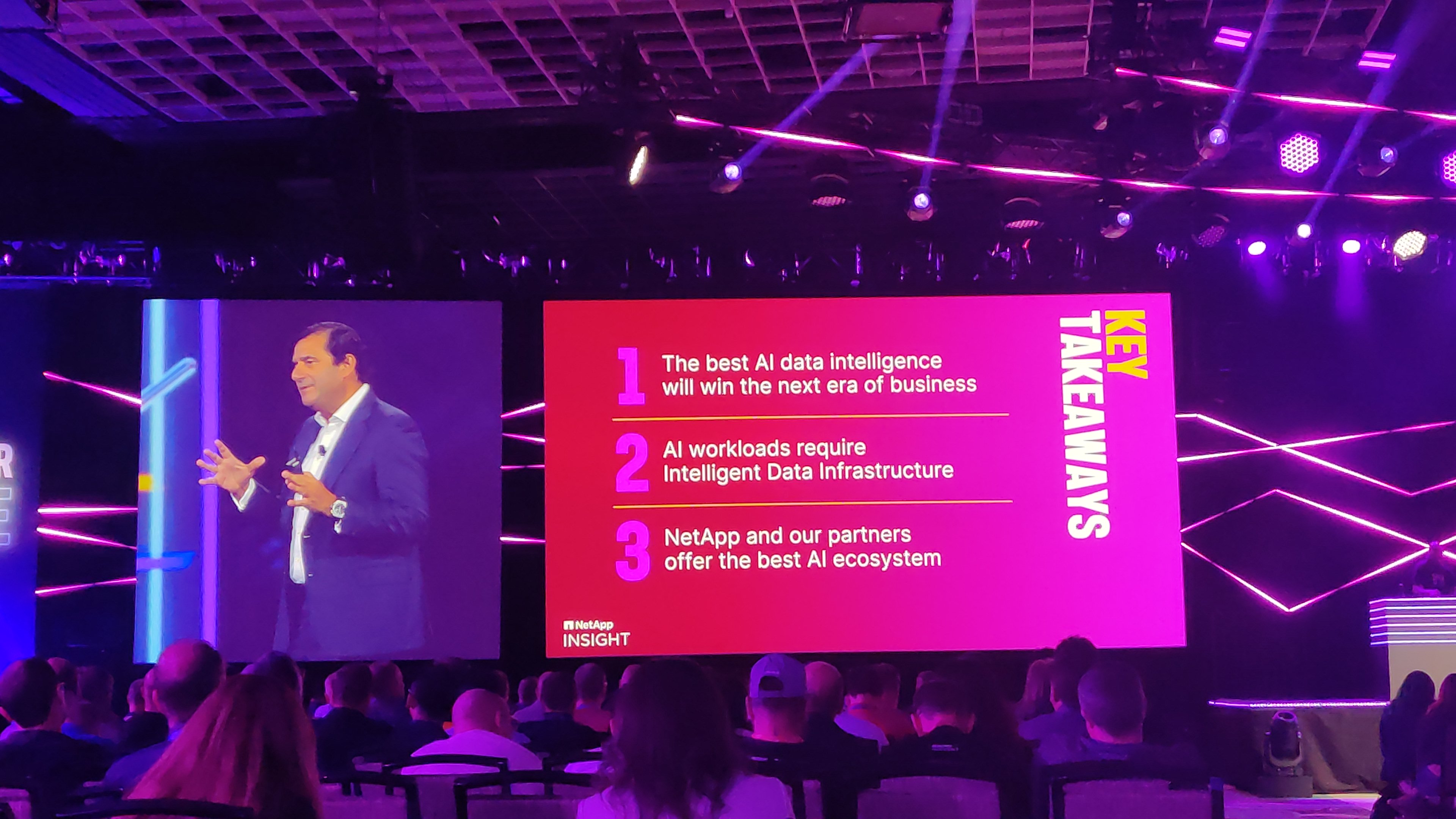
Cernuda flashes the dates for the next Insight 2025 conference, and begins thanking all of the stakeholders that have made the conference what it is.
Cernuda says goodbye, DJ Graffiti gets the music going once again and the audience is steadily making their way out of the auditorium.
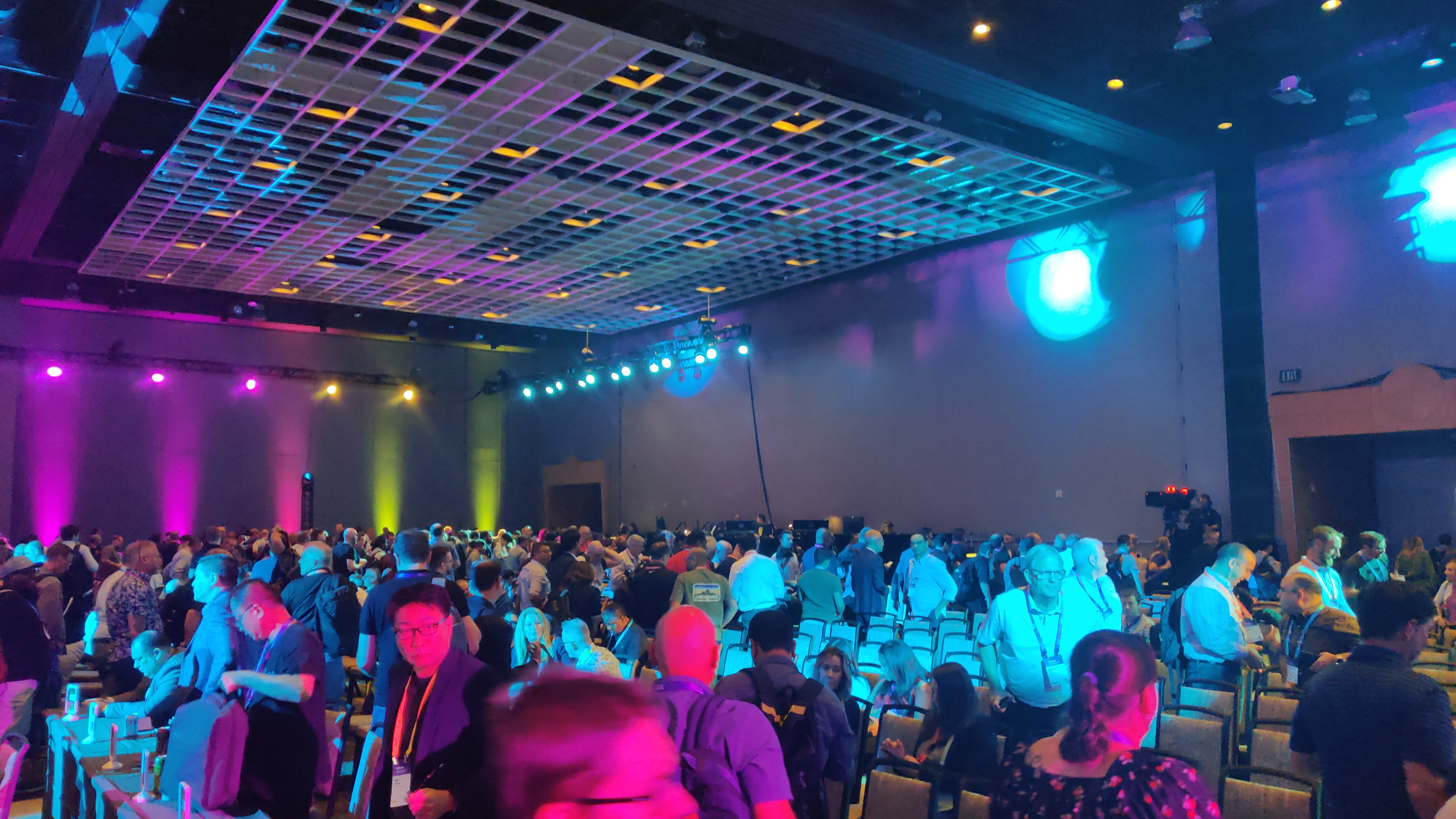
And that is it for for keynote presentations at NetApp Insight 2024, here's a quick wrap up of the key takeaways and announcements from last three days:
● Unveiling of the ASA A-Series, NetApp's all-flash block storage SAN array, including the ASA A70, A90, and A1K
● Two new secondary storage products, the FAS 70 and FAS 90, offering features like auto-data tiering, and and air-gapped cyber fault functionality
● Nvidia SuperPod certification for ONTAP
● New AI-powered ransomware detection feature in ONTAP, NetApp ONTAP Autonomous Ransomware Protection with AI (ARP/AI)
● A disaggregated storage architecture for future NetApp products and releases, including a global metadata namespace to bring structure to unstructured datasets and enabled improved RAG AI systems
We hope you've enjoyed ITPro's live coverage of all the presentations this year at NetApp Insight 2024 in Las Vegas, and be sure to read our ongoing coverage of the conference that will take a deeper dive into what we've seen over the last few days
